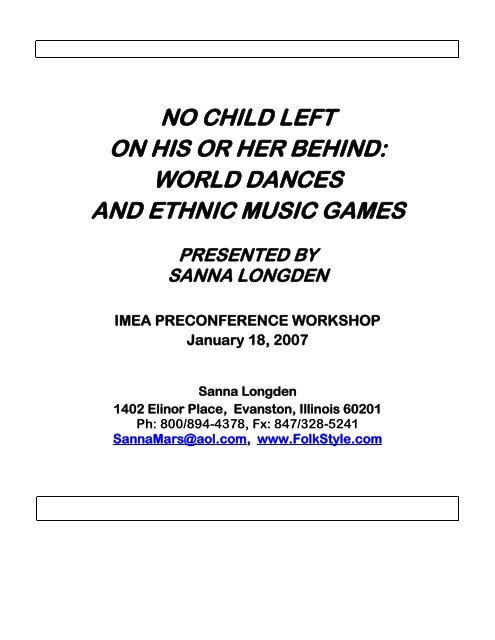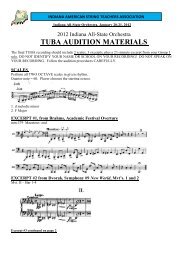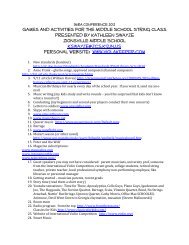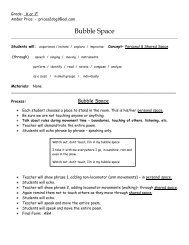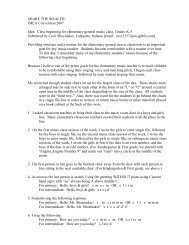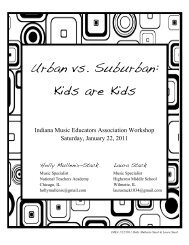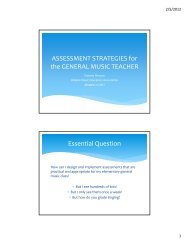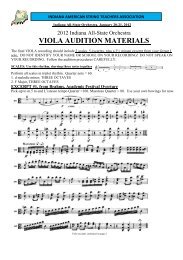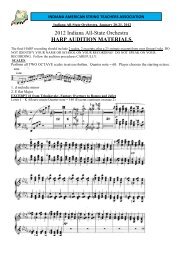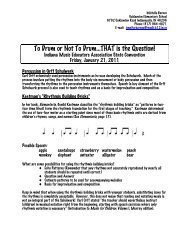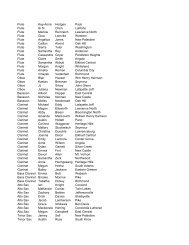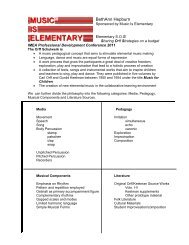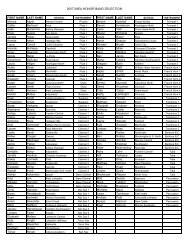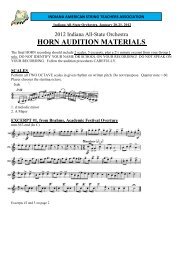no child left on his or her behind - Indiana Music Education ...
no child left on his or her behind - Indiana Music Education ...
no child left on his or her behind - Indiana Music Education ...
Create successful ePaper yourself
Turn your PDF publications into a flip-book with our unique Google optimized e-Paper software.
NO CHILD LEFT<br />
ON HIS OR HER BEHIND:<br />
WORLD DANCES<br />
AND ETHNIC MUSIC GAMES<br />
PRESENTED BY<br />
SANNA LONGDEN<br />
IMEA PRECONFERENCE WORKSHOP<br />
January 18, 2007<br />
Sanna L<strong>on</strong>gden<br />
1402 Eli<str<strong>on</strong>g>no</str<strong>on</strong>g>r Place, Evanst<strong>on</strong>, Illi<str<strong>on</strong>g>no</str<strong>on</strong>g>is 60201<br />
Ph: 800/894-4378, Fx: 847/328-5241<br />
SannaMars@aol.com, www.FolkStyle.com
SANNA’S SYLLABUS<br />
TABLE OF CONTENTS AND DISCOGRAPHY<br />
Name of Dance Sanna’s <strong>or</strong> ot<strong>her</strong> CD Sanna’s DVD/video<br />
Aloha Kakahiaka (Hawai’i) #1-1/2 #3 (aqua)<br />
B<strong>on</strong>jour, Mes Amis (Cajun) Making <strong>Music</strong>, Grade 1<br />
Debke (Arabic line dance) #3 #6 (white-blue)<br />
Ee Yay Yay (Asian/Internati<strong>on</strong>al) --- ---<br />
El Juego Chirimbolo (Ecuad<strong>or</strong>) #3 #6 (white-blue)<br />
Good Old Days (USA hand jive) #1-1/2 #1 (red)<br />
Grand March (USA traditi<strong>on</strong>al) #2 #5 (cinnam<strong>on</strong>)<br />
Groundhog Swing (Woodchuck) Making <strong>Music</strong>, Grade 3<br />
Hashual (Israeli “fox” game) #3 #6 (white-blue)<br />
Here Comes Sally (Afr.-Amer. l<strong>on</strong>gways) #3 #6 (white-blue)<br />
Highlife (W. Africa/Caribbean) #1 #3 (aqua)<br />
Hoe Ana (Tahitian ca<str<strong>on</strong>g>no</str<strong>on</strong>g>e dance) #4 #7 (blue-white)<br />
How Do You Dootee (Australia) Making <strong>Music</strong>, Grade 4 #2 (purple)<br />
I Let Her Go-Go (Trinidad/Tobago) ---- #7 (blue-white)<br />
I Love a Rainy Night (Tex-Mex) #2 #5 (cinnam<strong>on</strong>)<br />
Jingle Bells (USA-Dutch mixer) #1-1/2 #1 (red)<br />
Mexican Clapping Game (Jalisco) #4 #7 (blue-white)<br />
Paddy O’Furniture Jig (USA trio) “Siege of Carrick” <strong>on</strong> #2 <str<strong>on</strong>g>no</str<strong>on</strong>g>ne (“Siege” <strong>on</strong> #4--green)<br />
Peace Round (USA-English ca<str<strong>on</strong>g>no</str<strong>on</strong>g>n) Making <strong>Music</strong>, Grade 4 <str<strong>on</strong>g>no</str<strong>on</strong>g>ne<br />
Penguin Dance (Antarctica) #4 #7 (blue-white)<br />
Sasha (Russian mixer) #1-1/2 <str<strong>on</strong>g>no</str<strong>on</strong>g>ne<br />
Valentine Dance (German partner mixer) Making <strong>Music</strong>, Grade 1 <str<strong>on</strong>g>no</str<strong>on</strong>g>ne<br />
Yan Petit (French “muscle” dance) #1 #2 (purple)<br />
Yesh Lanu Taish (Israeli l<strong>on</strong>gways) #1 #1 (red)
ALOHA KAKAHIAKA<br />
(Hawai'i)<br />
"Good m<strong>or</strong>ning"<br />
"Hula" does <str<strong>on</strong>g>no</str<strong>on</strong>g>t mean <strong>on</strong>ly Hawaiian tourism, but has a l<strong>on</strong>g and <str<strong>on</strong>g>no</str<strong>on</strong>g>ble past. F<strong>or</strong> most of Hawai'i's<br />
<strong>his</strong>t<strong>or</strong>y (pro<str<strong>on</strong>g>no</str<strong>on</strong>g>unced ha-VAH-ee <strong>or</strong> ha-WAH-ee), chanted tales were the way bards preserved its<br />
traditi<strong>on</strong>s. Gestures with hands and bodies were skills taught by hula masters. At first, the kahiko<br />
<strong>or</strong> religious hula sung in Hawai’ian, was danced <strong>on</strong>ly by men, but later women were allowed to<br />
study t<strong>his</strong> art. With the coming of Christian missi<strong>on</strong>aries in the 19th century, hulas were outlawed<br />
f<strong>or</strong> many years and <str<strong>on</strong>g>no</str<strong>on</strong>g>t c<strong>on</strong>sidered respectable, but many c<strong>on</strong>tinued to dance. Both men and women<br />
wear the sh<strong>or</strong>t skirt <strong>or</strong> pa’u with a wreath <strong>or</strong> flowers <strong>on</strong> their heads <strong>or</strong> a lei around their necks.<br />
T<strong>her</strong>e is m<strong>or</strong>e than <strong>on</strong>e style of hula, but all use the graceful hand and body moti<strong>on</strong>s to tell st<strong>or</strong>ies.<br />
"Aloha Kakahiaka" (ah-LOH-hah kah-kah-hee-AH-kah) is a hapa haole hula, a type of fun dance<br />
sung usually f<strong>or</strong> tourists and <str<strong>on</strong>g>child</str<strong>on</strong>g>ren in English. Sanna learned the dance from Marilyn McGriff, a<br />
student of Anita Bradley, an expert in Hawaiian and Polynesian dance, who also taught Sanna t<strong>his</strong><br />
style of hula.<br />
CD, DVD/Video: The music can be found <strong>on</strong> Sanna’s CD# 1½. T<strong>his</strong> dance is instructed <strong>on</strong><br />
Sanna’s Video/DVD #3, Living Ethnic Dances f<strong>or</strong> Kids & Teac<strong>her</strong>s (aqua).<br />
Basic Hula Step (vamp, basic, <strong>or</strong> kaholo)<br />
Both feet flat <strong>on</strong> flo<strong>or</strong> <strong>or</strong> ground with knees bent and upper body straight.<br />
Moving sideways to R: Side, close, side, touch; repeat to L. C<strong>on</strong>tinue to move to R, then L while using<br />
gestures of dance. (Or begin to L first—<str<strong>on</strong>g>no</str<strong>on</strong>g> hard and fast rule <strong>her</strong>e.)<br />
Basic hand moti<strong>on</strong>s: Hands wave twice in <strong>on</strong>e directi<strong>on</strong>, then twice in the ot<strong>her</strong>, with flexible<br />
wrists and fingers leading. Sometimes men lead with fists instead of fingers. One arm is bent<br />
across the chest with the thumb at mid-breast; the ot<strong>her</strong> arm and hand reach out to the side. Some<br />
hula schools teach that hands move in same directi<strong>on</strong> as feet; some teach that hands move in the<br />
opposite directi<strong>on</strong>. F<strong>or</strong> <str<strong>on</strong>g>child</str<strong>on</strong>g>ren, it usually is easier to move everything the same way.<br />
See ot<strong>her</strong> side f<strong>or</strong> hand pattern of ―Aloha Kakahiaka.‖ Melody f<strong>or</strong> the s<strong>on</strong>g is below.<br />
<strong>Music</strong> transcripti<strong>on</strong> by Marilyn McGriff and Mars L<strong>on</strong>gden<br />
Movements<br />
(Hand moti<strong>on</strong>s <strong>on</strong> next page)
(Meant as a reminder f<strong>or</strong> those who have been taught the dance)<br />
Introducti<strong>on</strong> Hula R + L Basic hand movements<br />
Verse 1<br />
1. ―Aloha Hula R Hands wave <strong>on</strong>ce twd mouth, R hand<br />
gestures, palm up, out to R<br />
2. ―ka-ka-hi-a-ka Hula L same as above with L hand to L<br />
3. ―means good m<strong>or</strong>ning Hula R Hands start low and make big<br />
circle like a sun, in fr<strong>on</strong>t of you<br />
4. ―to you.‖ Hula L Hands reach out from waist<br />
Repeat all of the above<br />
Ch<strong>or</strong>us<br />
5. ―Alooo-ha, Hula R + L Same as #1 and #2<br />
6. ―Alooo-ha, Hula R + L Same as #1 and #2, reaching a bit<br />
fart<strong>her</strong> back to R and L<br />
7. ―Alooo-ha.‖ Hula R + L Both hands reach twd audience,<br />
palms up, and slowly pull apart<br />
Interlude Hula R + L Basic hands to R + L<br />
Verse 2<br />
8. ―Aloha Hula R same as #1<br />
9. ―e moi Hula L same as #2<br />
10. ―means good night Hula R Dream moti<strong>on</strong>--R cheek laid <strong>on</strong> both<br />
hands, palms toget<strong>her</strong>, eyes closed<br />
11. ―to you.‖ Hula L same as #4<br />
Repeat all of the above<br />
Repeat Ch<strong>or</strong>us<br />
Bow Point R foot f<strong>or</strong>ward, arms toget<strong>her</strong> straight in fr<strong>on</strong>t, face up,<br />
and smile.<br />
__________________________________________________________________________<br />
PRESENTED BY SANNA LONGDEN<br />
Notes by Sanna L<strong>on</strong>gden ©2006, based <strong>on</strong> those by Anita Bradley and Marilyn McGriff.
DEBKY<br />
(Arabic)<br />
The debky is <strong>on</strong>e of the most comm<strong>on</strong> dances of the Arabic peoples, whet<strong>her</strong> they are<br />
Egyptian, J<strong>or</strong>danian, Palestinian, Lebanese, Syrian, <strong>or</strong> from ot<strong>her</strong> Arab lands, <strong>or</strong> whet<strong>her</strong><br />
they are expatriates in ot<strong>her</strong> nati<strong>on</strong>s. The w<strong>or</strong>d debky is sometimes called debke, dubka,<br />
debka, <strong>or</strong> ot<strong>her</strong> w<strong>or</strong>ds in different countries. (As it is transliterated from the Arabic<br />
alphabet, t<strong>her</strong>e may be spelling variants in English.)<br />
The Arabic w<strong>or</strong>d, dabk, means to stamp <strong>on</strong>e’s foot. T<strong>her</strong>e are many debky figures;<br />
each regi<strong>on</strong> has its own, and improvisati<strong>on</strong> is encouraged. Two basic patterns are described<br />
below. The first is a h<strong>or</strong>a figure comm<strong>on</strong> in the dances of sout<strong>her</strong>n Europe (e.g., Greece,<br />
Romania, Serbia, etc.) and western Asia (e.g., Armenia, Israel, Turkey, etc.). A h<strong>or</strong>a figure<br />
is a six-beat pattern <strong>on</strong> a four-beat measure with myriad variati<strong>on</strong>s.<br />
(F<strong>or</strong> ot<strong>her</strong> h<strong>or</strong>a-type dances in Sanna’s resources, see ―Hoy Nergiz/Toi Nergis‖<br />
from Armenia <strong>on</strong> t<strong>his</strong> CD and/<strong>or</strong> DVD/video, as well as the Israeli ―H<strong>or</strong>a‖ <strong>on</strong> Sanna’s<br />
DVD/video #1 (red) and CD #1, and the Greek ―Servihassapikos‖ <strong>on</strong> <strong>her</strong> DVD/video #3<br />
(aqua) and CD #1-1/2. DVD/video #3 and CD #1-1/2 also include a patterned debky dance,<br />
―Ya Abud‖).<br />
<strong>Music</strong>/DVD/video: On Sanna’s CD#3 and DVD/video#6, both Volume 1 in Dances of the<br />
Seven C<strong>on</strong>tinents. The music rec<strong>or</strong>ded <strong>her</strong>e is Egyptian, but the debky can be danced to<br />
numerous tunes with appropriate rhythm. It can also be an adjunct to Arabic<br />
drumming (tabla, dumbek, darabukah) less<strong>on</strong>s and perf<strong>or</strong>mances. Meter: 4/4<br />
F<strong>or</strong>mati<strong>on</strong>: Sh<strong>or</strong>t lines of perhaps five to eight people f<strong>or</strong> teaching purposes.<br />
Traditi<strong>on</strong>ally, lines <strong>or</strong> open circles may be sh<strong>or</strong>t <strong>or</strong> l<strong>on</strong>g—at parties they may snake around<br />
the room. Hands may be joined down at the side <strong>or</strong> clasped at the waist with dancers<br />
moving shoulder-to-shoulder in a tight f<strong>or</strong>mati<strong>on</strong> to the right (counterclockwise), but, again,<br />
with many variati<strong>on</strong>s. Sometimes pairs dance toget<strong>her</strong> inside <strong>or</strong> outside the circle. In some<br />
societies, women and men may dance in separate lines and groups, <strong>or</strong> even different rooms.<br />
Styling: Instead of the m<strong>or</strong>e h<strong>or</strong>iz<strong>on</strong>tal leaps and jumps of the Israeli and Greek h<strong>or</strong>as,<br />
debky steps are usually up-and-down, as well as sharp and powerful, with str<strong>on</strong>g stamps,<br />
hops, and kicks. Note that a stamp doesn’t take weight; the next step is <strong>on</strong> the same foot.<br />
One basic pattern (similar to H<strong>or</strong>a) Moving to the right (CCW), starting with R foot:<br />
Step R (ct 1), step L (ct 2), step R (ct 3), stamp L (ct 4), step L (ct 5), stamp R (ct 6).<br />
A<str<strong>on</strong>g>no</str<strong>on</strong>g>t<strong>her</strong> basic pattern Moving to the right (CCW), starting with L foot:<br />
Step L across R (ct 1), step <strong>on</strong> R (ct 2), step L across R (ct 3), step <strong>on</strong> R (ct 4), hop <strong>on</strong> R<br />
while bending L knee <strong>or</strong> kicking L foot f<strong>or</strong>ward (ct 5), stamp <strong>on</strong> L foot w/o weight (ct 6).<br />
Variati<strong>on</strong>s may include step-hops, double stamps, crossing steps, turns, etc.<br />
____________________________________<br />
PRESENTED BY SANNA LONGDEN. Notes by Sanna L<strong>on</strong>gden © 2006,<br />
with inf<strong>or</strong>mati<strong>on</strong> from Stephanie and Elias Abudayeh, and ot<strong>her</strong>s.<br />
EL JUEGO CHIRIMBOLO
(Ecuad<strong>or</strong>)<br />
―El Juego Chirimbolo‖ [el HWAY-goh chee-reem-BOH-loh] is played by young <str<strong>on</strong>g>child</str<strong>on</strong>g>ren in<br />
Ecuad<strong>or</strong>. Chirimbolo is a kind of <str<strong>on</strong>g>no</str<strong>on</strong>g>nsense w<strong>or</strong>d that refers to some s<strong>or</strong>t of c<strong>on</strong>trapti<strong>on</strong> <strong>or</strong><br />
machine movement. A traditi<strong>on</strong>al singing game, it was presented to U.S. educat<strong>or</strong>s by<br />
Elizabeth Villarreal Brennan. The object is to do it faster each time the game repeats.<br />
<strong>Music</strong>, video/DVD: On Sanna’s CD#3 and DVD/video #6, Dances of the Seven C<strong>on</strong>tinents, Vol. 1<br />
(white and blue <strong>on</strong>e), sung by Ms. Villarreal Brennan. Meter: 4/4<br />
F<strong>or</strong>mati<strong>on</strong>: Traditi<strong>on</strong>ally, partners face in two lines, like l<strong>on</strong>gways sets, with any number of<br />
pairs that fits. F<strong>or</strong> easy teaching <strong>or</strong> younger learners <strong>or</strong> crowded rooms, Sanna has pairs<br />
scattered around the dance space. Partners hold two hands.<br />
S<strong>on</strong>g and Movement Pattern<br />
Although Rs & Ls are indicated, young <str<strong>on</strong>g>child</str<strong>on</strong>g>ren may use eit<strong>her</strong> pie, ma<str<strong>on</strong>g>no</str<strong>on</strong>g>, and codo.<br />
I. FIRST TIME. El juego chirimbolo, que b<strong>on</strong>ito es (the Chirimbolo game, how beautiful it<br />
is): All moving in the same directi<strong>on</strong> (toward <strong>on</strong>e wall <strong>or</strong> the ot<strong>her</strong>), take 4 side-close steps:<br />
side, close; side, close; side, close; side, close (if L foot) <strong>or</strong> touch (if R foot) (<strong>or</strong> whichever).<br />
C<strong>on</strong> un pie (with a foot): Partners extend R feet and tap the flo<strong>or</strong> next to each ot<strong>her</strong>’s foot.<br />
Otro pie (ot<strong>her</strong> foot): They do the same with their L feet.<br />
Una ma<str<strong>on</strong>g>no</str<strong>on</strong>g>, otra ma<str<strong>on</strong>g>no</str<strong>on</strong>g> (<strong>on</strong>e hand, ot<strong>her</strong> hand): Partners pat R hands, then L hands.<br />
Un codo, otro codo (<strong>on</strong>e elbow, ot<strong>her</strong> elbow): Partners touch R elbows, then L elbows.<br />
II. SECOND TIME. El juego chirimbolo, que b<strong>on</strong>ito es, . . . :<br />
Repeat the 4 side-close steps in the opposite directi<strong>on</strong>, then c<strong>on</strong>tinue the game as above.<br />
III. CODA/FINALE. El juego chirimbolo: 4 side-close steps in the <strong>or</strong>iginal directi<strong>on</strong>.<br />
Que b<strong>on</strong>ito es: Partners do the Wring the Dishrag/Suzie Q/Double-Pretzel figure—Still<br />
holding two hands, they swing their arms up and over in a circle (in the same directi<strong>on</strong> they<br />
were just moving) while turning back-to-back and ending face-to-face.<br />
Hey! Partners drop hands, fling them up with fingers spread as they jump and land, then<br />
hold the pose—<strong>or</strong> any ot<strong>her</strong> dramatic <strong>on</strong>e-beat ending.<br />
REPEAT the whole pattern at the faster tempo, then perhaps sing it faster and faster.<br />
_____________________________________<br />
PRESENTED BY SANNA LONGDEN. Notes by Sanna L<strong>on</strong>gden ©2006 based <strong>on</strong> those by<br />
Elizabeth Villarreal Brennan and ot<strong>her</strong>s.
GOOD OLD DAYS<br />
(U.S.A)<br />
T<strong>his</strong> type of hand-jive has been around since the 1950s; the s<strong>on</strong>g was first rec<strong>or</strong>ded in 1965,<br />
singing about the 1920’s, and is in the Charlest<strong>on</strong> style. It is useful as a warm-up dance f<strong>or</strong><br />
older primary kids and teens. T<strong>her</strong>e are ot<strong>her</strong> ch<strong>or</strong>eographies f<strong>or</strong> "Good Old Days"; see the<br />
next page f<strong>or</strong> a partner mixer that can also be d<strong>on</strong>e by individuals al<strong>on</strong>e.<br />
<strong>Music</strong>, Video/DVD: "Good Old Days" was <strong>or</strong>iginally sung by Roger Miller. T<strong>his</strong> versi<strong>on</strong> is<br />
found <strong>on</strong> Sanna’s CD #1 ½ (with permissi<strong>on</strong>). The hand-jive is taught <strong>on</strong> Sanna’s<br />
Video/DVD #1, Fav<strong>or</strong>ite Folk Dances of Kids & Teac<strong>her</strong>s (red). Meter: 4/4<br />
F<strong>or</strong>mati<strong>on</strong>: Dancers scattered around room <strong>or</strong> in a loose circle, facing center. It can also<br />
be d<strong>on</strong>e while sitting in chairs <strong>or</strong> <strong>on</strong> the flo<strong>or</strong>, <strong>or</strong> walking around c<strong>on</strong>necting with ot<strong>her</strong>s.<br />
Hand-Jive Pattern<br />
Measures<br />
SLAP, SLAP; CLAP, CLAP; SLICE, SLICE; SLICE, SLICE;<br />
POUND, POUND; POUND, POUND; SHAKE, SHAKE; SHAKE, SHAKE<br />
1 Slap thighs two times with both hands; clap own hands two times.<br />
2 Pass R hand 2 times over L hand with palms down; switch hands, repeat.<br />
3 Pound R fist 2 times <strong>on</strong> L fist; repeat with fists switched.<br />
4 Hold R elbow with L hand and shake R f<strong>or</strong>efinger 2 times; repeat <strong>on</strong> L side.<br />
HITCHHIKE<br />
5-6 Lean R and ―hitchhike‖ with R thumb in small jerks from fr<strong>on</strong>t to back 8 times.<br />
7-8 Lean to L and repeat with L thumb.<br />
SWIM<br />
9-10 ―Swim,‖ making <strong>on</strong>e breast stroke in 4 beats, then repeat. Take a big step toward<br />
center with each of the strokes.<br />
TWIRL LASSO AND TURN<br />
11-12 Raising R arm, f<strong>or</strong> 8 beats ―twirl lasso‖ <strong>or</strong> make small circles with R f<strong>or</strong>efinger<br />
while turning full circle to R (CW) in 4 steps.<br />
13-14 Repeat with L arm and hand, turning full circle to L (CCW) in 4 steps.<br />
PLUCK, PLACE, SLAP, BLOW<br />
15-16 Pluck ―something‖ from the air with R fingers; place it firmly into L palm,<br />
17-18 slap L palm with R hand; blow it off palm.<br />
(see <str<strong>on</strong>g>no</str<strong>on</strong>g>tes f<strong>or</strong> partner mixer/individual pattern <strong>on</strong> next page)
Good Old Days, page 2<br />
Partner Mixer/Individual Pattern<br />
F<strong>or</strong>mati<strong>on</strong>: Partners standing side-by-side in a double circle, both facing counterclockwise<br />
(CCW), with inside hands joined. It can also be d<strong>on</strong>e by single individuals in the circle <strong>or</strong> in<br />
scattered f<strong>or</strong>mati<strong>on</strong>. If in pairs, each partner starts <strong>on</strong> the outside foot: The pers<strong>on</strong> <strong>on</strong> <str<strong>on</strong>g>left</str<strong>on</strong>g>,<br />
the inside pers<strong>on</strong> (traditi<strong>on</strong>ally the man) starts <strong>on</strong> the L foot; the pers<strong>on</strong> <strong>on</strong> the right, the<br />
outside pers<strong>on</strong> (the ―woman‖) starts <strong>on</strong> the R foot).<br />
Measures<br />
INTRODUCTION. Get in the mood during the 4 measures <strong>or</strong> 16 beats.<br />
PART I. HEEL-STEPS, APART-TOGETHERS, STRUTTING<br />
1 Touch (<str<strong>on</strong>g>no</str<strong>on</strong>g> weight) outside heel f<strong>or</strong>ward, step in place <strong>on</strong> the same foot (take<br />
weight) (cts 1-2). Repeat the touch-step with the ot<strong>her</strong> foot (cts 3-4).<br />
2 With both feet toget<strong>her</strong> and flat <strong>on</strong> the flo<strong>or</strong>, move heels apart-toget<strong>her</strong>apart-toget<strong>her</strong>,<br />
<strong>or</strong> out-in-out-in (cts. 5-8).<br />
3 - 4 Starting <strong>on</strong> outside foot, take 4 steps f<strong>or</strong>ward with a little strut<br />
(cts 9-16—2 beats per step).<br />
5 - 8 Repeat measures 1-4 (cts 1-16).<br />
PART II. CHARLESTON, REPEAT ABOVE, MEET NEW PARTNER<br />
1 – 2 Charlest<strong>on</strong> figure: Step f<strong>or</strong>ward <strong>on</strong> outside foot (cts 1-2), kick inside foot<br />
f<strong>or</strong>ward <strong>or</strong> touch it in fr<strong>on</strong>t (cts 3-4), step backward <strong>on</strong> outside foot (cts 5-6),<br />
touch inside foot in back (cts. 7-8).<br />
3 – 4 Repeat Charlest<strong>on</strong> figure (step, kick <strong>or</strong> touch, step, touch) (cts 9-16).<br />
5 Repeat 2 heel-steps of Part I, meas. 1 (cts 1-4).<br />
6 Repeat 2 apart-toget<strong>her</strong>s of Part I, meas. 2 (cts 5-8).<br />
7 – 8 Starting <strong>on</strong> the outside foot, the inside pers<strong>on</strong> takes 4 strutting steps while<br />
turning in a half-circle to L, moving back to the pers<strong>on</strong> <strong>behind</strong> in the circle.<br />
The outside pers<strong>on</strong>, starting <strong>on</strong> the outside foot, takes 4 strutting steps<br />
f<strong>or</strong>ward to meet the new partner who is making the half-circle to the back.<br />
_________________________________<br />
PRESENTED BY SANNA LONGDEN. Notes by Sanna L<strong>on</strong>gden ©2006, based <strong>on</strong> those of Marian<br />
and Ned Gault, C<strong>on</strong>stance Mynatt and Bernard Kaiman, and Phyllis Weikart.
THE GRAND MARCH<br />
(Processi<strong>on</strong>al from many countries as well as U.S. Eastern-seaboard Col<strong>on</strong>ial<br />
Almost every ball in the late 18 th century began with a Grand March, as well as dance parties in many<br />
European countries. It helps to have a leader near the music to direct the dancers. T<strong>his</strong> dance is taught <strong>on</strong><br />
Sanna’s DVD/video#5, Hist<strong>or</strong>ic & C<strong>on</strong>temp<strong>or</strong>ary Dances f<strong>or</strong> Kids & Teac<strong>her</strong>s.<br />
<strong>Music</strong>: On Sanna’s CD#2 (―Sweet Richard,‖ a Col<strong>on</strong>ial tune played <strong>on</strong> period instruments from ―American<br />
Country Dances of the Revoluti<strong>on</strong>ary Era, 1775-1795," by The Hendricks<strong>on</strong> Group, used with permissi<strong>on</strong>).<br />
Ot<strong>her</strong> marches are also useful.<br />
To start: Traditi<strong>on</strong>ally, the Grand March began with couples f<strong>or</strong>ming a l<strong>on</strong>g column <strong>behind</strong> a lead pair.<br />
Ot<strong>her</strong> ways to begin: Men line up al<strong>on</strong>g <strong>on</strong>e side, women al<strong>on</strong>g the ot<strong>her</strong>, facing down the hall. The first<br />
two in each line walk toward each ot<strong>her</strong> and proceed up the hall side-by-side as every<strong>on</strong>e follows, joining up<br />
with some<strong>on</strong>e from the ot<strong>her</strong> side. Or start every<strong>on</strong>e in <strong>on</strong>e straight line facing the music, then c<strong>on</strong>tinued<br />
to alternate to right and <str<strong>on</strong>g>left</str<strong>on</strong>g> down the hall w<strong>her</strong>e they meet some<strong>on</strong>e from the ot<strong>her</strong> side and c<strong>on</strong>tinue up<br />
the hall as above.<br />
C<strong>on</strong>tinuing: As pairs come toward the music, the leader directs the first couple to the right, sec<strong>on</strong>d to the<br />
<str<strong>on</strong>g>left</str<strong>on</strong>g>, third to the right, and so <strong>on</strong>. Couples proceed down the outside of the column, meet at the center back,<br />
join up with a<str<strong>on</strong>g>no</str<strong>on</strong>g>t<strong>her</strong> couple, and come up the center by fours, linking arms.<br />
Each rank of four turns to right <strong>or</strong> <str<strong>on</strong>g>left</str<strong>on</strong>g>, meets at the back of the hall, and comes up the center by eights. If<br />
the group and the hall is large e<str<strong>on</strong>g>no</str<strong>on</strong>g>ugh, repeat f<strong>or</strong> sixteens—even thirty-twos!<br />
Getting back to pairs, singles, <strong>or</strong> circle: Reverse the acti<strong>on</strong>: Eights split into fours at the top of the<br />
hall, walk down to the bottom, and come up the center still in fours. Then fours split into twos, remaining<br />
in twos as they come down the center. F<strong>or</strong> a l<strong>on</strong>gways dance, keep them in pairs and break off the column<br />
in sets of six <strong>or</strong> whatever is needed.<br />
Ot<strong>her</strong> figures from t<strong>his</strong> point could be tunnels and arches, dip and dive, alleys, <strong>or</strong> ot<strong>her</strong>s. F<strong>or</strong> a double<br />
circle of couples, the column of pairs could bend into a large circle.<br />
To get back to individuals, c<strong>on</strong>tinue the reverse acti<strong>on</strong> and split the pairs into <strong>on</strong>es until they come up the<br />
hall in a single parade.<br />
Getting into a circle from ranks of eight: Each rank of eight should stop in a straight line, <str<strong>on</strong>g>no</str<strong>on</strong>g>t too<br />
close to the line ahead. Unlink arms and join hands. Pers<strong>on</strong> of the L end of the first rank leads the line to<br />
the L between the sec<strong>on</strong>d and third ranks, then between third and fourth, and so <strong>on</strong>. Pers<strong>on</strong> <strong>on</strong> the L end<br />
of the sec<strong>on</strong>d rank grabs the last hand that comes by. T<strong>his</strong> c<strong>on</strong>tinues until the whole group is in <strong>on</strong>e l<strong>on</strong>g<br />
winding line with hands joined. All should be facing in toward center.<br />
The leader can <str<strong>on</strong>g>no</str<strong>on</strong>g>w wind the group into a spiral, then unwind into a snake <strong>or</strong> similar figures. Finally, the<br />
whole group ends up in a large single circle (the leader cleverly guiding them until he/she can join hands<br />
with the last pers<strong>on</strong>. Now is the time f<strong>or</strong> a big cheer!<br />
_______________________<br />
PRESENTED BY SANNA LONGDEN. Notes by Sanna L<strong>on</strong>gden ©2006, based <strong>on</strong> lots of dancing.
HASHUAL<br />
(Israel = “The Fox”)<br />
―Hashual‖ [hah-shoo-AHL], a <str<strong>on</strong>g>child</str<strong>on</strong>g>ren’s game dance from the early days of Israel, is a<br />
fav<strong>or</strong>ite with <str<strong>on</strong>g>child</str<strong>on</strong>g>ren and families. The fox, in the center of the circle, has been caught<br />
stealing the farmer's grapes, so we must catch him/<strong>her</strong>. Below are two versi<strong>on</strong>s: The<br />
<strong>or</strong>iginal <strong>on</strong>e by ch<strong>or</strong>eograp<strong>her</strong> Rivka Sturman and composer E. Zamir, created in 1950<br />
(both circle and partner patterns), and a modified <strong>on</strong>e by Sanna f<strong>or</strong> youngsters who have<br />
<str<strong>on</strong>g>no</str<strong>on</strong>g>t learned the grapevine figure <strong>or</strong> the two-step.<br />
<strong>Music</strong>, DVD/video: Sanna’s CD#3 and DVD/video#6, in <strong>her</strong> Dances of the Seven C<strong>on</strong>tinents<br />
two-volume set (both the <strong>or</strong>iginal circle dance and Sanna’s adaptati<strong>on</strong>). Ot<strong>her</strong> CDs are also<br />
available. Meters: A true mixed-meter melody, moving from 2/4 to 3/4 to 4/4.<br />
F<strong>or</strong>mati<strong>on</strong>: Closed circle, hands joined down in V positi<strong>on</strong>. The ―fox‖ is in the center.<br />
S/he is sleeping, having eaten too many grapes. F<strong>or</strong> a large group, add m<strong>or</strong>e foxes.<br />
Original Dance<br />
Introducti<strong>on</strong>: Wait out instrumental introducti<strong>on</strong>, begin <strong>on</strong> vocal.<br />
Measures<br />
PART I. Circling and Grapevine<br />
1 (4/4) Starting <strong>on</strong> R, walk 4 steps to R, counterclockwise, clapping hands <strong>on</strong> cts 3&4.<br />
2 (3/4) C<strong>on</strong>tinue with three m<strong>or</strong>e walking steps, R, L, R (cts 5, 6, 7).<br />
3 (2/4) Begin the grapevine step: Cross L in fr<strong>on</strong>t of R (ct 1), step R to side (ct 2),<br />
4 (3/4) C<strong>on</strong>tinue it: Cross L in back (ct 3), R to side (ct 4), cross L in fr<strong>on</strong>t (ct 5),<br />
5 (3/4) Close R to L (ct 6), step L to L side (ct 7), brush R across L (ct 8) and face R.<br />
6 – 9 Repeat measures 1-4.<br />
10 (2/4) Close R to L (ct 1), step L to L side (ct 2). Do <str<strong>on</strong>g>no</str<strong>on</strong>g>t brush t<strong>his</strong> time!<br />
PART II. In and out toward the fox (2/4 meter)<br />
1 – 4 Start <strong>on</strong> R, take 4 two-steps to center. Bend slightly, leading with R shoulder<br />
and hand as R foot leads, then with L, snapping fingers (cts 1-8).<br />
5 – 8 Stomp <strong>on</strong> R while clapping near R knee (ct 9), then move backward out of circle<br />
in 7 steps starting <strong>on</strong> L, circling arms up and around to sides (cts 10-16).<br />
9 – 16 Repeat measures 1-8, Part II, going in and out of the circle.<br />
Hashual, p. 2<br />
(c<strong>on</strong>tinued)
Or finish it as a PARTNER DANCE<br />
(If using t<strong>his</strong> pattern, partners should be chosen at start of dance)<br />
9 – 12 Partners face and circle each ot<strong>her</strong> CCW, snapping fingers.<br />
13 -16 Partners do-si-do past L shoulders, raising and lowering arms as in meas. 5-8.<br />
Modificati<strong>on</strong> by Sanna L<strong>on</strong>gden<br />
PART I: Around the circle<br />
1 - 5 Walk 15 steps counterclockwise to R around circle; hands are <str<strong>on</strong>g>no</str<strong>on</strong>g>t joined.<br />
Clap-clap-clap <strong>on</strong> cts 3&4. Start to turn clockwise (to L) cts 13-15.<br />
6 - 10 Walk 14 steps clockwise; clapping <strong>on</strong> cts 3&4. Face center <strong>on</strong> ct 14 (<str<strong>on</strong>g>no</str<strong>on</strong>g> 15!).<br />
PART II: Toward the fox(es) and back away<br />
1 - 4 Move toward fox (<strong>or</strong> foxes) with 8 small steps <strong>or</strong> 4 two-steps, bending and<br />
snapping fingers as above (cts 1-8).<br />
5 - 8 On next step (ct 1), stamp + clap hands low, then back out in 7 steps,<br />
moving arms as above. Some groups also clap again <strong>on</strong> ct. 5—it seems to<br />
keep people <strong>on</strong> beat better.<br />
9 - 12 Repeat moving toward fox. T<strong>his</strong> time, <strong>on</strong> the clap, the fox taps <strong>or</strong> points at<br />
some<strong>on</strong>e else to be the new fox and joins the circle in <strong>his</strong>/<strong>her</strong> place.<br />
13 – 16 Every<strong>on</strong>e backs out of the circle in 7 steps as above, to end facing R to begin<br />
circling again.<br />
____________________________________<br />
PRESENTED BY SANNA LONGDEN.<br />
Notes by Sanna L<strong>on</strong>gden © 2006, based <strong>on</strong> those of Rivka Sturman.
HERE COMES SALLY<br />
(African-American)<br />
T<strong>his</strong> versi<strong>on</strong> of the well-k<str<strong>on</strong>g>no</str<strong>on</strong>g>wn playparty is from the African-American traditi<strong>on</strong>. It is the<br />
ancest<strong>or</strong> of ―The Stroll,‖ a U.S. party dance. The descripti<strong>on</strong> below is found in Shake It to<br />
the One that You Love the Best: Play S<strong>on</strong>gs and Lullabies from Black <strong>Music</strong>al Traditi<strong>on</strong>s,<br />
collected and adapted by C<strong>her</strong>yl Warren Mattox, and published <strong>her</strong>e with permissi<strong>on</strong>. It<br />
is similar to ―Zudio,‖ a dance from the Afro-American <strong>her</strong>itage that was first described by<br />
Mrs. Bessie J<strong>on</strong>es and Bess Lomax Hawes in their classic book, Step It Down (1972).<br />
<strong>Music</strong>, video/DVD: On Sanna’s CD#3 and DVD/video #6, Dances of the Seven C<strong>on</strong>tinents, Vol. 1<br />
(white and blue <strong>on</strong>e). Meter: 4/4<br />
F<strong>or</strong>mati<strong>on</strong>: Partners face in l<strong>on</strong>gways sets (two facing lines) of about 4 to 8 pairs.<br />
Styling: Relaxing and improvisati<strong>on</strong>al, with great attenti<strong>on</strong> to the beat.<br />
Dance Game<br />
In the spirit of the culture and of Mrs. Bessie J<strong>on</strong>es, t<strong>his</strong> descripti<strong>on</strong> has minimal structure<br />
and much room f<strong>or</strong> improvisati<strong>on</strong> and individualized movements.<br />
Start by moving in place and clapping hands. When the vocalist sings, ―Step back, Sally,‖<br />
move away from your partner to make an alley between the lines.<br />
Suggested footw<strong>or</strong>k could be ―stepping it down‖: Step <strong>on</strong> <strong>on</strong>e foot, then touch the ot<strong>her</strong><br />
foot without weight while clapping hands and/<strong>or</strong> snapping fingers. Repeat with opposite<br />
footw<strong>or</strong>k. Repeat t<strong>his</strong> in place, then away and toward partners.<br />
First two people sashay down the alley, then next two, then next two, and so <strong>on</strong>.<br />
Pantomime the acti<strong>on</strong>s of the s<strong>on</strong>g, <strong>or</strong> make up your own movements.<br />
As the active pair moves down the ―alley,‖ all the ot<strong>her</strong>s hitch sideways toward the top <strong>or</strong><br />
head of the set. It is <str<strong>on</strong>g>no</str<strong>on</strong>g>t necessary f<strong>or</strong> the next top people to wait 8 <strong>or</strong> ot<strong>her</strong> number of<br />
beats bef<strong>or</strong>e starting down the alley—they should go when the spirit moves them.<br />
Sometimes the acti<strong>on</strong> might pause while every<strong>on</strong>e touches a toe ―to the fr<strong>on</strong>t, to the back,<br />
to the side-side-side,‖ then repeats with the ot<strong>her</strong> foot.<br />
The s<strong>on</strong>g goes through <strong>on</strong>ly <strong>on</strong>ce <strong>on</strong> the rec<strong>or</strong>ding, so repeat as many times as seems<br />
good—at least so every<strong>on</strong>e has at least <strong>on</strong>e turn to strut down the alley. Of course, after<br />
the first time through the rec<strong>or</strong>ding, every<strong>on</strong>e could keep <strong>on</strong> singing.<br />
____________________________________<br />
PRESENTED BY SANNA LONGDEN. Notes by Sanna L<strong>on</strong>gden © 2006, based <strong>on</strong> Shake<br />
It to the One that You Love the Best, Step It Down, and ot<strong>her</strong>s.
HIGHLIFE <strong>or</strong> PANDOGA<br />
(Ghana, West Africa)<br />
"Highlife" is the general name f<strong>or</strong> a type of West African dance. T<strong>his</strong> Highlife,<br />
Pandoga, was arranged and taught in the early 1970s by Dick Oakes, based <strong>on</strong><br />
elements from dances of the Ewe, Ga, Ashanti, and Y<strong>or</strong>uba tribes of Ghana. Though<br />
African dances are usually improvisati<strong>on</strong>al, t<strong>his</strong> is a useful and fun pattern. Dick<br />
Oates wrote: "These figures may vary from individual to individual and should <strong>on</strong>ly<br />
be taken as approximati<strong>on</strong>s of actual movements and as refres<strong>her</strong> <str<strong>on</strong>g>no</str<strong>on</strong>g>tes . . ." Ideas<br />
f<strong>or</strong> improvisati<strong>on</strong> are below.<br />
Background: During the late-19th to mid-20th century, West African cultures were<br />
influenced by European col<strong>on</strong>izers. Highlife is a combinati<strong>on</strong> of European social dance<br />
and indige<str<strong>on</strong>g>no</str<strong>on</strong>g>us folk movements, using both Western and African instruments. Similar<br />
hybrid music has also developed in the West Indies. [From <str<strong>on</strong>g>no</str<strong>on</strong>g>tes of T<strong>on</strong>y Shay, f<strong>or</strong>mer<br />
direct<strong>or</strong> of Aman Ensemble].<br />
Rec<strong>or</strong>dings, Video/DVD: <strong>Music</strong> f<strong>or</strong> "Highlife" is found Sanna’s CD#1, Folk Dance<br />
<strong>Music</strong> f<strong>or</strong> Kids & Teac<strong>her</strong>s, with permissi<strong>on</strong> from Aman Folk Ensemble. Aman<br />
learned t<strong>his</strong> music from Kwazi Badu, lecturer in music of Ghana at UCLA and<br />
f<strong>or</strong>mer member of the University of Ghana's dance troupe. T<strong>his</strong> rec<strong>or</strong>ding uses<br />
drums and double g<strong>on</strong>gs typical of Ghanaian village music. Highlife music can also<br />
be found <strong>on</strong> many West African rec<strong>or</strong>dings. T<strong>his</strong> pattern is taught <strong>on</strong> Sanna’s<br />
Video/DVD #3, Living Ethnic Dances f<strong>or</strong> Kids & Teac<strong>her</strong>s (aqua).<br />
Styling: Individuals scattered around room facing center. Bend elbows at sides,<br />
f<strong>or</strong>earms parallel to flo<strong>or</strong> and held loosely, f<strong>or</strong>efingers pointing down--relax!<br />
<strong>Music</strong>: 8/16 ―Bell pattern" -- 8 counts: 1 2 3 4 5 6 7 8 = 1 basic step<br />
Basic step: (Ct 1) Touch R heel twd ctr, straighten L leg, point at R toe w/ R<br />
f<strong>or</strong>efinger, drop R shoulder; (ct 3) step <strong>on</strong> R w/ bent knees, square shoulders; (ct 5)<br />
touch L heel twd ctr w/ straight R leg, point at L toe w/ L f<strong>or</strong>efinger, drop L shoulder;<br />
(ct 7) step <strong>on</strong> L w/ bent knees, squaring shoulders.<br />
Dance Pattern<br />
(T<strong>his</strong> descripti<strong>on</strong> is meant to reinf<strong>or</strong>ce learning from w<strong>or</strong>kshop and/<strong>or</strong> video)<br />
Introducti<strong>on</strong>: 2 "bell patterns" (<str<strong>on</strong>g>no</str<strong>on</strong>g> acti<strong>on</strong>)<br />
10 BASIC STEPS<br />
4 SAWING: palms down, L above R, knees bent, cutting moti<strong>on</strong>s down to R + L<br />
4 PRAYING DOWN: hands in prayer, small circles, squatting gradually to beat<br />
4 EGG BEATING: staying down, mixing moti<strong>on</strong> under <strong>on</strong>e elbow, then the ot<strong>her</strong><br />
4 PRAYING UP: reverse movements of PRAYING DOWN<br />
(c<strong>on</strong>tinued <strong>on</strong> ot<strong>her</strong> side)
Highlife/Pandoga, page 2<br />
4 BASIC STEPS moving out a bit<br />
4 SMALL DRUM: 3 steps + lift in place, "beating" drum with hands in fr<strong>on</strong>t<br />
4 LARGE DRUM: 3 steps + kick to R, then L, "beating" big drum to L side<br />
4 SMALL DRUM: as above<br />
4 BASIC STEPS in place<br />
4 BIG CHICKEN: knees spread, hands <strong>on</strong> thighs, elbows flap, moving in, ½ turns<br />
4 FLYING CHICKEN: same positi<strong>on</strong>, elbows to side, palms to flo<strong>or</strong>, in 2 + out 2<br />
4 BIG CHICKEN: same as above, moving out<br />
4 BASIC STEPS in place<br />
4 SWIMMING IN PLACE: exaggerated "crawl stroke," feet toget<strong>her</strong>, knees bent<br />
4 SWIMMING TO CENTER: same movements and positi<strong>on</strong>, hitch f<strong>or</strong>ward<br />
4 SWIMMING IN PLACE: same as above<br />
4 BASIC STEPS moving backward out of center<br />
4 WAVING CHICKEN: BIG CHICKEN positi<strong>on</strong>, waving 1 hand, then ot<strong>her</strong>, moving<br />
in toward center.<br />
3 BASIC STEPS moving backward out of center<br />
POSE in WAVING CHICKEN positi<strong>on</strong> while stamping foot<br />
_____________________________________<br />
PRESENTED BY SANNA LONGDEN.<br />
Notes by Sanna L<strong>on</strong>gden © 2006, based <strong>on</strong> those of Dick Oakes and T<strong>on</strong>y Shay.
HOE ANA<br />
(Rarot<strong>on</strong>ga Islands/Tahiti)<br />
"Hoe Ana" is <strong>or</strong>iginally a Rarot<strong>on</strong>gan folk s<strong>on</strong>g, from the islands west of Tahiti, also called<br />
Cook Islands. Acc<strong>or</strong>ding to Paul Tavai Latta (www.PaulLatta.com), the Tahitians have<br />
claimed and perf<strong>or</strong>med it, thus a bit of c<strong>on</strong>fusi<strong>on</strong> about <strong>or</strong>igin. The dance is of the Kaparima<br />
style <strong>or</strong> "Acti<strong>on</strong> Dance," with hand gestures descriptive of the text. It tells of the days when<br />
Polynesian people migrated from island to island, paddling <strong>on</strong> and <strong>on</strong> to reach a legendary<br />
place just over the h<strong>or</strong>iz<strong>on</strong>. T<strong>her</strong>e are several versi<strong>on</strong>s. T<strong>his</strong> was taught by Yves M<strong>or</strong>eau to the<br />
internati<strong>on</strong>al folk dance community.<br />
F<strong>or</strong>mati<strong>on</strong>: Standing, kneeling, <strong>or</strong> sitting in columns as though in ca<str<strong>on</strong>g>no</str<strong>on</strong>g>es.<br />
<strong>Music</strong>, video/DVD: On Sanna's CD #4 and Volume 2 of <strong>her</strong> Dances of the Seven<br />
C<strong>on</strong>tinents two-volume set (blue and white). Different versi<strong>on</strong>s are shown.<br />
Measure St<strong>or</strong>y Movement Introducti<strong>on</strong>:<br />
Wait f<strong>or</strong> ch<strong>or</strong>us to start singing bef<strong>or</strong>e beginning<br />
PART I<br />
1-2 waves start with R hand.<br />
lift it up and over your head, returning to<br />
starting positi<strong>on</strong><br />
3--4 waves repeat with L hand<br />
5-8 rock ca<str<strong>on</strong>g>no</str<strong>on</strong>g>e rock gently from R,L,R,L<br />
9-16 repeat repeat measures 1-8<br />
17-18 swirl the water <strong>on</strong>e hand <strong>on</strong> top of the ot<strong>her</strong>, make circular<br />
moti<strong>on</strong>s <strong>on</strong> R side going CW<br />
19-20 swirl the water same as 1-2, except <strong>on</strong> L and CCW<br />
21-24 look f<strong>or</strong> the land hands over eyes, like shading from sun look<br />
R,L,R,L<br />
25-28 sun and mo<strong>on</strong> hold hands, fists closed at chest level,<br />
elbows up, (ct. 1) , open R hand up<br />
and out (ct. 2), return R hand to chest (ct. 3),<br />
open L hand up and out to L (ct. 4).<br />
Return hand to chest (and)<br />
(c<strong>on</strong>tinued)
Hoe Ana, p.2<br />
29-32 the 4 directi<strong>on</strong>s starting at R, both hands/arms reach up<br />
and to the R (ct. 1) , return down (ct. &) ,<br />
up and a little to L, c<strong>on</strong>tinuing until<br />
completed 4 times.<br />
PART II<br />
1-2 paddle, paddle Pretend to hold a paddle, do 2<br />
strokes <strong>on</strong> R side, singing "Hoe Anna, hoe anna‖<br />
3-4 paddle <str<strong>on</strong>g>left</str<strong>on</strong>g> Repeat 1-2 <strong>on</strong> L side, singing.<br />
4-8 paddles Repeat meas. 1-4<br />
9-12 swirl the water Repeat meas. 1-4 in Part I.<br />
13 the land to me Stretch arms out, parallel to flo<strong>or</strong>, palms out,<br />
in fr<strong>on</strong>t of body.<br />
14 ― ― Curl arms in toward chest<br />
15-16 Repeat meas. 13-14.<br />
PART III Fast <strong>Music</strong><br />
1-8 Paddle R/L Repeat Part II, meas. 1-8.<br />
(Sing, "Hoy, hoy, hey, hey")<br />
9-12 All the stars are Hands move over head from R to<br />
in the sky L, fingers flickering open/closed (1&2&3&4&) 8<br />
times, quickly.<br />
13-14 dive into wave Hands over head like diving into water,<br />
hands scoop down and up, head bobs down<br />
and up also<br />
15-16 clap, clap 2 claps <strong>on</strong> the beat.<br />
17-32 Repeat Part III, meas. 1-32.<br />
Repeat complete dance from the beginning.<br />
F<strong>or</strong> s<strong>on</strong>g lyrics and music transcripti<strong>on</strong>, see syllabus that accompanies Sanna’s CD<br />
and DVD.
HOW DO YOU DOO-TEE<br />
(Australia)<br />
T<strong>his</strong> hum<strong>or</strong>ous music game is a communal greeting activity d<strong>on</strong>e regularly at<br />
programs of the nati<strong>on</strong>al Australian family music associati<strong>on</strong> called "Parents f<strong>or</strong><br />
<strong>Music</strong>." It was presented in the U.S. at the 1994 American Orff-Schulwerk<br />
c<strong>on</strong>ference by André de Quadros, currently a Bost<strong>on</strong>-area music educat<strong>or</strong>, who<br />
was teaching in Australia at the time.<br />
<strong>Music</strong>, Video/DVD: Although it is usually a speech piece, a rec<strong>or</strong>ding -- complete<br />
with digiridoo-- is included in Silver Burdett Ginn’s series, Making <strong>Music</strong>, Grade<br />
4. In additi<strong>on</strong>, ―How Do You Doo-tee‖ is dem<strong>on</strong>strated <strong>on</strong> Sanna’s purple<br />
video/DVD, M<strong>or</strong>e Fav<strong>or</strong>ite Folk Dances f<strong>or</strong> Kids & Teac<strong>her</strong>s.<br />
Movement Pattern<br />
(1) Start in a closed circle, your own arms crossed <strong>on</strong>e over the ot<strong>her</strong>, holding hands<br />
with people <strong>on</strong> eit<strong>her</strong> side. Turn head to <strong>on</strong>e side. Say:<br />
"How do you doo-tee, how do you doo-tee, how do you do today [to-DYE]?"<br />
(2) Change crossed arms with the ot<strong>her</strong> arm <strong>on</strong> top, and turn head the ot<strong>her</strong> way.<br />
Say:<br />
"Do you live w<strong>her</strong>e you used to live, <strong>or</strong> have you shifted away [ah-WHY]?"<br />
(3) Change crossed arms to the first c<strong>on</strong>figurati<strong>on</strong>, and turn head the first way.<br />
Say:<br />
"I'm s<strong>or</strong>ry you're so disagreeable--I <strong>on</strong>ly stopped to say [SIGH],"<br />
(4) Drop arms and move quickly to a<str<strong>on</strong>g>no</str<strong>on</strong>g>t<strong>her</strong> place in the circle, while saying:<br />
"How do you doo-tee, how do you doo-tee, how do you do today [to-DYE]!"<br />
As you rejoin the circle, cross your arms and begin again.<br />
It adds even m<strong>or</strong>e excitement if the chant increases in tempo with each repetiti<strong>on</strong>.<br />
_______________________<br />
PRESENTED BY SANNA LONGDEN.<br />
Notes by Sanna L<strong>on</strong>gden © 2005, based <strong>on</strong> pattern taught by André de Quadros.
I LET HER GO-GO<br />
(Trinidad and Tobago)<br />
T<strong>his</strong> singing game from the island country of Trinidad and Tobago is great fun f<strong>or</strong><br />
kindergarten through third grade. Located in the Caribbean off the coast of Venezuela,<br />
Trinidad is k<str<strong>on</strong>g>no</str<strong>on</strong>g>wn f<strong>or</strong> its Carnival celebrati<strong>on</strong> and Tobago is Robins<strong>on</strong> Crusoe’s island.<br />
DVD/video: Shown <strong>on</strong> Sanna’s DVD/video#7, Volume 2 in <strong>her</strong> Dances of the Seven<br />
C<strong>on</strong>tinents (blue and white). It has <str<strong>on</strong>g>no</str<strong>on</strong>g>t been rec<strong>or</strong>ded, as it is meant to be sung. The music<br />
transcripti<strong>on</strong> is below. Meter: 4/4<br />
F<strong>or</strong>mati<strong>on</strong>: A single circle with partners facing each ot<strong>her</strong>.<br />
Dance Pattern<br />
If the partner is a boy, of course we say, ―I let him go-go.‖<br />
♫ I let <strong>her</strong> go-go,<br />
Partners pat hands two times <strong>on</strong> ―go-go.‖<br />
♫ Ee-ay, I let <strong>her</strong> go-go,<br />
Each pers<strong>on</strong> claps <strong>his</strong>/<strong>her</strong> own hands twice <strong>on</strong> ―go-go.‖<br />
♫ Eeay, I let <strong>her</strong> go, . . .<br />
Partners put hands toget<strong>her</strong> <strong>on</strong> ―go . . .‖ and walk in a half circle to change places.<br />
Teac<strong>her</strong> may hold that ―go . . .‖ as l<strong>on</strong>g <strong>or</strong> as sh<strong>or</strong>t as desired to encourage listening.<br />
♫ I let <strong>her</strong> go-go-go!<br />
Partners pat each ot<strong>her</strong>’s <strong>or</strong> their own hands three times, then jump around to face the<br />
pers<strong>on</strong> <strong>on</strong> their ot<strong>her</strong> side. T<strong>his</strong> is the next partner.<br />
Game may c<strong>on</strong>tinue until all are back to their <strong>or</strong>iginal partners—<strong>or</strong> <str<strong>on</strong>g>no</str<strong>on</strong>g>t.<br />
_______________________<br />
PRESENTED BY SANNA LONGDEN.<br />
Notes by Sanna L<strong>on</strong>gden ©2006, based <strong>on</strong> those by Marilyn Sousa and Rosie Castleberry.
I LOVE A RAINY NIGHT<br />
(Double-line U.S. Country-Western Dance)<br />
T<strong>his</strong> dance was ch<strong>or</strong>eographed to a specific country/western s<strong>on</strong>g, but t<strong>her</strong>e are similar ―line‖<br />
dance patterns, such as ―Swinging <strong>on</strong> a Gate.‖ Sanna learned it from Romanian dance teac<strong>her</strong>,<br />
Sunni Bloland, who learned it from a dance teac<strong>her</strong> in Fl<strong>or</strong>ida. It is especially appropriate f<strong>or</strong><br />
upper elementary students; see below, however, f<strong>or</strong> a modified versi<strong>on</strong>. It is taught <strong>on</strong> Sanna’s<br />
DVD/video #5, Hist<strong>or</strong>ic & C<strong>on</strong>temp<strong>or</strong>ary Dances.<br />
<strong>Music</strong>: Arranged to "I Love a Rainy Night" by the late Eddie Rabbit; it could be danced to many<br />
ot<strong>her</strong> s<strong>on</strong>gs. On Sanna’s CD#2 (with permissi<strong>on</strong>) and Eddie Rabbit rec<strong>or</strong>dings. Meter: 4/4<br />
F<strong>or</strong>mati<strong>on</strong>: Partners (d<strong>on</strong>'t have to be opposite gender) in a l<strong>on</strong>g double line <strong>or</strong> l<strong>on</strong>gways<br />
f<strong>or</strong>mati<strong>on</strong>. Each pers<strong>on</strong> faces <strong>his</strong>/<strong>her</strong> partner across the set, as in the Virginia Reel.<br />
Dance Pattern<br />
Measures<br />
Part 1. Toes out & in (8 beats)<br />
1- 4 Weight <strong>on</strong> both feet: R toe points out, in, out, in, out, in, out, in.<br />
Part 2. Tapping (8 beats)<br />
5 - 8 Stand <strong>on</strong> L: Tap R in fr<strong>on</strong>t, in fr<strong>on</strong>t, in back, in back, fr<strong>on</strong>t, back, side, lift R knee.<br />
Part 3. Side toget<strong>her</strong> sides (8 beats)<br />
9 - 12 R to side, L toget<strong>her</strong> <strong>or</strong> cross in back, R to side, touch L (clap!).<br />
Repeat with opposite footw<strong>or</strong>k to the <str<strong>on</strong>g>left</str<strong>on</strong>g>.<br />
Add turns when it feels good, <strong>or</strong> ot<strong>her</strong> individual movements.<br />
Part 4. Cross to partner’s side (8 beats)<br />
13 - 16 Point R shldrs, pass back-to-back: R foot to side (ct 1), L toget<strong>her</strong> (ct 2), R to side<br />
ct 3), hold <strong>on</strong> R and pivot CW to face partner (ct 4), back into partner’s place <strong>on</strong><br />
L (ct 5), R (ct 6), L (ct 7), hold (ct 8).<br />
Stay <strong>on</strong> partner’s side to start dance again. Dance with your whole body and sing al<strong>on</strong>g!<br />
“Swinging <strong>on</strong> a Gate” pattern d<strong>on</strong>e by country-western dancers:<br />
Do Part 1 (toes out & in) f<strong>or</strong> <strong>on</strong>ly 4 beats, then c<strong>on</strong>tinue pattern.--off the s<strong>on</strong>g but <strong>on</strong> the beat!<br />
Sanna’s modified variant f<strong>or</strong> younger learners:<br />
Part 1: Same as above but use eit<strong>her</strong> foot.<br />
Part 2: Tap with R <strong>or</strong> L foot 7 times, then raise the same knee <strong>on</strong> 8 th beat.<br />
Part 3: Take 3 steps in place, clap <strong>on</strong> 4 th beat; repeat.<br />
Part 4: Join both hands with partner, change places, finish with 3 claps.<br />
PRESENTED BY SANNA LONGDEN.<br />
Notes by Sanna L<strong>on</strong>gden ©2001, based <strong>on</strong> dance as taught by Sunni Bloland.
MEXICAN CLAPPING GAME<br />
(M<strong>on</strong>terrey, Mexico)<br />
T<strong>his</strong> hand-clapping game was collected by Nelda Guerrero Drury, a well-k<str<strong>on</strong>g>no</str<strong>on</strong>g>wn teac<strong>her</strong> of<br />
Mexican dances, when she visited a school in M<strong>on</strong>terrey. As the <str<strong>on</strong>g>child</str<strong>on</strong>g>ren <strong>on</strong> the playground<br />
knew, it has many possibilities f<strong>or</strong> improvisati<strong>on</strong>.<br />
<strong>Music</strong>, DVD/video: On Sanna’s CD #4 and DVD/video#7, both Volume 2 in <strong>her</strong> Dances of the<br />
Seven C<strong>on</strong>tinents two-volume set (blue and white). The tune used, with permissi<strong>on</strong>, is<br />
Richie Valens’s popular arrangement of the traditi<strong>on</strong>al s<strong>on</strong>g, ―La Bamba.‖ Any Mexican<br />
polka <strong>or</strong> upbeat Mexican s<strong>on</strong>g will also w<strong>or</strong>k. Nelda rep<strong>or</strong>ts that the youngsters from whom<br />
she learned it were clapping to their own singing of popular s<strong>on</strong>gs.<br />
F<strong>or</strong>mati<strong>on</strong>: First, pairs stand somew<strong>her</strong>e in the room to practice the basic clapping<br />
pattern (below). Then they join a<str<strong>on</strong>g>no</str<strong>on</strong>g>t<strong>her</strong> pair of partners so that groups of four are scattered<br />
around the dance space. If two people--<strong>or</strong> <strong>on</strong>e plus teac<strong>her</strong>--are <str<strong>on</strong>g>left</str<strong>on</strong>g>, they may join a quad<br />
after the acti<strong>on</strong> gets going. Later, m<strong>or</strong>e pairs can be added to these groups. Partners are<br />
facing and across from each ot<strong>her</strong> in the circle, with clapping hands in the center.<br />
Count 1<br />
Count 2<br />
Count 3<br />
Count 4<br />
Basic clapping pattern (4 beats)<br />
Clap two hands with partner. (Cue: ―Partner‖)<br />
Clap your own hands toget<strong>her</strong>. (Cue: ―Self‖)<br />
Clap your hands <strong>behind</strong> your own back. (Cue: ―In back‖)<br />
Clap your hands in fr<strong>on</strong>t about waist-high. (Cue: ―In fr<strong>on</strong>t‖)<br />
The game<br />
Decide which pair goes first (sometimes the hardest part!).<br />
The first pair begins the pattern with counts 1 and 2 (―Partner, Self‖).<br />
When t<strong>his</strong> pair is <strong>on</strong> count 3 (―In back), the ot<strong>her</strong> pair starts <strong>on</strong> count 1 (―Partner‖).<br />
The pattern goes <strong>on</strong> with claps 1 & 2 raised and claps 3 & 4 lowered to avoid bumps.<br />
Variati<strong>on</strong>s <strong>on</strong> the theme, as seen in many classrooms<br />
--Partners may sway in and out <strong>on</strong> counts 1 and 2.<br />
--One <strong>or</strong> both partners may turn as they clap counts 3 and 4.<br />
--Two groups may c<strong>on</strong>nect to have 8 people clapping in myriad patterns.<br />
--Extra pairs may join in to have 10 <strong>or</strong> 12 <strong>or</strong> . . . .<br />
--Two people may kneel <strong>on</strong> opposite sides and reach through the legs.<br />
--Two people may jump to reach over the heads.<br />
--Whatever!<br />
____________________________________<br />
PRESENTED BY SANNA LONGDEN.<br />
Notes by Sanna L<strong>on</strong>gden ©2006, after observing and c<strong>on</strong>sulting with Nelda G. Drury.
THE PADDY O’FURNITURE JIG<br />
(s<strong>or</strong>t of Irish)<br />
<strong>or</strong><br />
WILD TURKEY<br />
(kind of traditi<strong>on</strong>al U.S.A)<br />
―Wild Turkey‖ is an enjoyable trio dance that has <str<strong>on</strong>g>no</str<strong>on</strong>g>thing whatever to do with<br />
Thanksgiving, but is fun to do then <strong>or</strong> any ot<strong>her</strong> time of the year. Sanna learned it from<br />
Karlene Manwaring of Salt Lake City, and has also adapted it f<strong>or</strong> St. Patrick’s Day as ―The<br />
Paddy O’Furniture Jig.‖<br />
F<strong>or</strong>mati<strong>on</strong>: Groups of threes, side by side, all facing counterclockwise (CCW) around the<br />
circle. The middle pers<strong>on</strong> in each trio is the ―turkey‖ <strong>or</strong> the ―leprechaun.‖<br />
<strong>Music</strong>: F<strong>or</strong> Wild Turkey, any 4/4 <strong>or</strong> 2/4 cheery music with a good beat and an AABB <strong>or</strong><br />
ABCD f<strong>or</strong>m. Sanna uses ―Virginia Reel‖ <strong>on</strong> <strong>her</strong> CD#2, M<strong>or</strong>e Folk Dance <strong>Music</strong> f<strong>or</strong> Kids &<br />
Teac<strong>her</strong>s.. When celebrating St. Pat’s, use any upbeat Irish reel (4/4, 2/4) <strong>or</strong> jig (6/8). Sanna<br />
uses ―Siege of Carrick,‖ also <strong>on</strong> <strong>her</strong> CD#2.<br />
Dance Pattern<br />
Beats<br />
I. Promenade<br />
16 Joining inside hands, all walk f<strong>or</strong>ward 16 steps.<br />
II. Circles<br />
8 Each group of three circles to the <str<strong>on</strong>g>left</str<strong>on</strong>g> in 8 steps.<br />
8 Trios circle to the right in 8 steps.<br />
III. Stars<br />
8 Each trio f<strong>or</strong>ms a right-hand star and walks clockwise in 8 steps.<br />
8 Each trio f<strong>or</strong>ms a <str<strong>on</strong>g>left</str<strong>on</strong>g>-hand star and walks counterclockwise in 8 steps.<br />
IV. The turkey/leprechaun takes off<br />
16 Still facing f<strong>or</strong>ward, the inside and outside people in each trio raise their joined<br />
hands to make a bridge <strong>or</strong> an arch. The ―turkey‖ <strong>or</strong> ―leprechaun‖ goes through the arch<br />
and around <strong>on</strong>e pers<strong>on</strong> (usually the right-hand <strong>or</strong> outside pers<strong>on</strong>), then through and<br />
around the ot<strong>her</strong> pers<strong>on</strong>, then through <strong>on</strong>ce m<strong>or</strong>e, going f<strong>or</strong>ward, to become the center<br />
pers<strong>on</strong> of the group ahead.<br />
NOTE: Make sure every<strong>on</strong>e has a chance to be the turkey <strong>or</strong> leprechaun.<br />
PRESENTED BY SANNA LONGDEN.<br />
Notes by Sanna L<strong>on</strong>gden © 2006, based <strong>on</strong> Karlene Manwaring’s descripti<strong>on</strong>.
PENGUIN DANCE<br />
(The Penguin People of Antarctica)<br />
T<strong>his</strong> dance <strong>or</strong>iginated in the Australian Antarctic Territ<strong>or</strong>y by the Penguin People as they<br />
observed the Sout<strong>her</strong>n Hemisp<strong>her</strong>e research stati<strong>on</strong> scientists at their recreati<strong>on</strong>al<br />
activities. As most of the scientists were from Australia and the British Isles, the figures of<br />
t<strong>his</strong> dance may seem familiar to those k<str<strong>on</strong>g>no</str<strong>on</strong>g>wledgeable about Anglo-American arts. Now it<br />
has become a pan-Penguin dance, popular am<strong>on</strong>g all of the family Spheniscidae.<br />
<strong>Music</strong>, DVD/video: On Sanna’s CD #4 and DVD/video#7, both Volume 2 in <strong>her</strong> Dances of the<br />
Seven C<strong>on</strong>tinents (blue and white). Rec<strong>or</strong>ded <strong>her</strong>e is the Shenanigan’s ―Lobster Quadrille,‖<br />
with permissi<strong>on</strong> by Gary King. Meter: 4/4<br />
F<strong>or</strong>mati<strong>on</strong>: L<strong>on</strong>gways f<strong>or</strong>mati<strong>on</strong> f<strong>or</strong> 3 to 5 pairs of Penguins.<br />
Styling: Move as though you had a nice round tummy, little flippered feet, a sharp beak,<br />
and l<strong>on</strong>g flexible pointed wings.<br />
Meas.<br />
Dance Pattern<br />
INTRODUCTION: The ship’s bell calls the Penguins to the dance and the<br />
acc<strong>or</strong>di<strong>on</strong> plays a measure.<br />
PART I, A music (f<strong>or</strong>ward and backward)<br />
1 – 2 Move toward partner in 4 walks (cts 1-4), then pat flippers <strong>on</strong> partner’s<br />
flipper 3 times in a ti-ti-ta rhythm (cts 5-8).<br />
3 – 4 Move away from partner in 4 walks (cts 1-4); stomp little legs 3 times<br />
(cts 5-8). Clap own flippers toget<strong>her</strong>, if desired, <strong>on</strong> stomps (heavy steps).<br />
5 – 8 Repeat above f<strong>or</strong>ward and backward movements.<br />
PART II, A1 music (flipper turns and do-si-dos)<br />
1 –4 Hooking R flippers with partner, walk around f<strong>or</strong> 8 cts; repeat with L flippers.<br />
5 – 8 Do R-shoulder do-si-do with partner (8 beats), then repeat with L shoulder.<br />
PART III, B music (peel the shrimp and make a bridge)<br />
1 – 8 Top two Penguins scuttle apart and down the hall to lead the ot<strong>her</strong>s in a castoff<br />
<strong>or</strong> peel the shrimp. When they reach the bottom, they make a two-flipper<br />
bridge f<strong>or</strong> the ot<strong>her</strong> Penguin pairs to come through and up to the top (16 cts).<br />
Repeat the above pattern two m<strong>or</strong>e times. At the coda, dip beaks to partners and<br />
audience, then flop off toward the ocean.<br />
______________________________________<br />
PRESENTED BY SANNA LONGDEN. Dance & descripti<strong>on</strong> by Sanna L<strong>on</strong>gden ©2006.
SASHA<br />
(Russia—Germany)<br />
―Sasha‖ is the nickname f<strong>or</strong> Russian boys named Alexander, and f<strong>or</strong> Russian girls named<br />
Alexandra <strong>or</strong> Alexandria, and it is a terrific dance. It may <str<strong>on</strong>g>no</str<strong>on</strong>g>t be really Russian (Bob<br />
Dalsemer, of the John C. Campbell Folk School, learned t<strong>his</strong> from a Danish teac<strong>her</strong> who<br />
learned it from a<str<strong>on</strong>g>no</str<strong>on</strong>g>t<strong>her</strong> Danish teac<strong>her</strong> who got it from a German folk dance leader).<br />
Whatever its <strong>or</strong>igin, it is an immediate hit with <str<strong>on</strong>g>child</str<strong>on</strong>g>ren and adults alike.<br />
<strong>Music</strong>: On Sanna’s CD-1-1/2 as well as John C. Campbell Folk School (1-800-FOLK-SCH),<br />
and Marian Rose’s CD-book package, ―Step Lively #1 (marian@istar.ca).<br />
Meter: 4/4<br />
F<strong>or</strong>mati<strong>on</strong>: Pairs standing anyw<strong>her</strong>e in the dance space. Start by partners facing.<br />
Dance Pattern<br />
I. “Sasha!”<br />
Partners shake index fingers at each ot<strong>her</strong> while saying, ―Sasha! Sasha! One-two-three!‖<br />
It’s even better to count in Russian: ―Rahss-dvah-tree‖ (roll those ―r’s‖).<br />
II. Clapping sequence<br />
Partners clap: Right hands three times—right-right-right<br />
Left hands three times—<str<strong>on</strong>g>left</str<strong>on</strong>g>-<str<strong>on</strong>g>left</str<strong>on</strong>g>-<str<strong>on</strong>g>left</str<strong>on</strong>g><br />
Both hands—both-both-both<br />
Pat knees—knees-knees-knees<br />
III. Elbow turns<br />
Partners hook right elbows and walk/swing in a clockwise circle 8 steps. On 8 th , give a<br />
sharp ―hey!‖ and switch to <str<strong>on</strong>g>left</str<strong>on</strong>g> elbows. Walk/swing counterclockwise with 8 steps and a<br />
―hey!‖<br />
IV. Promenade al<strong>on</strong>e<br />
Walk around the dance space al<strong>on</strong>e, in any directi<strong>on</strong>, until it’s time to start the pattern<br />
again with a new partner. Face some<strong>on</strong>e nearby (<str<strong>on</strong>g>no</str<strong>on</strong>g> fair reserving partners ahead of time)<br />
and begin again with ―Sasha! Sasha!‖<br />
PRESENTED BY SANNA LONGDEN. Notes by Sanna L<strong>on</strong>gden © 2006, based <strong>on</strong> those of<br />
Bob Dalsemer, Marian Rose, and first observance at a c<strong>on</strong>tra dance party in 1997.
SWING DANCING<br />
A teaching progressi<strong>on</strong> f<strong>or</strong> the basic East-coast, six-count Swing pattern<br />
Swing dancing is a true U.S. folk dance that started in the late 1920s in the ballrooms of<br />
Harlem. In the 1930s, it was called the Lindy Hop after aviat<strong>or</strong>, Charles Lindbergh. Over<br />
the decades, the dance has also been called Jitterbug, Be-Bop, and Boogie-Woogie. Now<br />
Swing variants are called East Coast, West Coast, Shag, and Lindy. Like traditi<strong>on</strong>al<br />
dances from any culture, it is improvisati<strong>on</strong>al within the basic structure. Fifth-grade<br />
through adult can enjoy Swing dance.<br />
<strong>Music</strong>, video/DVD: Modern Swing music fuses rock and jazz styles, but the Big Band<br />
sound is still the fav<strong>or</strong>ite. A fav<strong>or</strong>ite tune, ―In the Mood,‖ is <strong>on</strong> Sanna’s CD#3. It is taught<br />
and dem<strong>on</strong>strated <strong>on</strong> <strong>her</strong> DVD/video #6, Dances of the Seven C<strong>on</strong>tinents, Vol. 1 (white and<br />
blue <strong>on</strong>e). Meter: 4/4<br />
One of the Basic Patterns f<strong>or</strong> the Six-Count, East-coast Swing<br />
1. Practice t<strong>his</strong> 6-beat pattern al<strong>on</strong>e—men <strong>or</strong> leaders start <strong>on</strong> L foot, women <strong>or</strong><br />
followers start <strong>on</strong> R foot. T<strong>his</strong> pattern takes <strong>on</strong>e and a half measures:<br />
Step <strong>on</strong>e foot a little to the side and pause, (beats 1, 2).<br />
Step <strong>on</strong> the ot<strong>her</strong> foot to the ot<strong>her</strong> side and pause (beats 3, 4)--d<strong>on</strong>’t make steps too wide.<br />
Step a bit backward <strong>on</strong> first foot (beat 5), step in place with ot<strong>her</strong> foot (beat 6).<br />
Cue: “Side, side, back-step,” <strong>or</strong> “Slow, slow, quick-quick”, <strong>or</strong> “Ta, ta, ti-ti.”<br />
T<strong>his</strong> pattern repeats over and over, always beginning <strong>on</strong> the same foot. On the ―slow, slow‖<br />
steps, many people instead do step-touches <strong>or</strong> triple steps (especially <strong>on</strong> slower tempos), but<br />
―side, side‖ is easiest at first. The ―quick-quick‖ is also called the rock step.<br />
2. Practice with a partner:<br />
The point of social dancing is that women and men dance as partners. It is also a dance<br />
traditi<strong>on</strong> that men are the ―leaders‖ and women are the ―followers.‖ However, partner up in<br />
whatever way is appropriate in the situati<strong>on</strong>. Perhaps every<strong>on</strong>e should practice both<br />
leading and following.<br />
The most positi<strong>on</strong> f<strong>or</strong> youngsters and adult beginners is the two-hand hold. Practice the<br />
basic pattern while staying in <strong>on</strong>e spot <strong>on</strong> the flo<strong>or</strong> (again, Leader starts <strong>on</strong> L foot, Follower<br />
<strong>on</strong> R). When comf<strong>or</strong>table with t<strong>his</strong>, try the basic pattern while moving around the flo<strong>or</strong> in a<br />
circle.<br />
Helpful tips f<strong>or</strong> good Swing styling:<br />
(a) Keep your feet underneath your t<strong>or</strong>so as much as possible—do <str<strong>on</strong>g>no</str<strong>on</strong>g>t step too widely <strong>on</strong> the<br />
side steps, <strong>or</strong> too far <strong>behind</strong> you <strong>on</strong> the back-step, <strong>or</strong> cross the back <strong>behind</strong> you.<br />
(c<strong>on</strong>tinued)
Swing dancing, page 2<br />
(b) Do <str<strong>on</strong>g>no</str<strong>on</strong>g>t lean your shoulders too far to each side—try to keep your head upright.<br />
(c) Do <str<strong>on</strong>g>no</str<strong>on</strong>g>t straighten your arms but bend your elbows a bit—that way you and your partner<br />
can step away and toget<strong>her</strong> as though you were c<strong>on</strong>nected by a small wire spring.<br />
(d) Leader gives signals to turn, etc., ahead of phrase; Follower should be leadable. Enjoy<br />
the c<strong>on</strong>necti<strong>on</strong>!<br />
3. Some figures:<br />
(a) Single turn—t<strong>his</strong> takes <strong>on</strong>e basic 6-beat pattern:<br />
Leader lifts L arm and does the basic pattern as Follower pivot-turns under that arm to R<br />
<strong>on</strong> ―slow, slow‖ steps. Leader steps in place as Follower starts the pivot-turn by pointing R<br />
toes to the R and a bit <strong>behind</strong> self <strong>on</strong> the first ―slow‖ step. Both finish facing partner <strong>on</strong> the<br />
back step <strong>or</strong> ―quick-quicks.‖ To end t<strong>his</strong> turn and begin the basic pattern again, Leader<br />
lowers L hand.<br />
(b) Double turn—t<strong>his</strong> takes two basic 6-beat patterns:<br />
Do <strong>on</strong>e single turn as above. After the ―quick-quick,‖ Leader immediately guides partner<br />
into a sec<strong>on</strong>d turn in the opposite directi<strong>on</strong> by gently swinging L arm across own body<br />
toward the R.<br />
Follower begins t<strong>his</strong> sec<strong>on</strong>d pivot-turn by stepping across <strong>on</strong> R foot to the L f<strong>or</strong> the first<br />
of the ―slow, slow‖ steps. She takes the ot<strong>her</strong> ―slow‖ step of t<strong>his</strong> pivot-turn by stepping<br />
<strong>behind</strong> self <strong>on</strong> L foot and pivoting around (counterclockwise) to face partner. Both finish<br />
facing, as much as possible, <strong>on</strong> the ―quick-quick‖ back step as in the single turn.<br />
(c) Changing places--t<strong>his</strong> takes <strong>on</strong>e basic 6-beat pattern:<br />
Leader raises L arm as each passes <strong>on</strong> L side with ―slow, slow‖ steps, going straight<br />
f<strong>or</strong>ward past partner <strong>on</strong> the first ―slow‖ step, then starting to turn (Leader to L, Follower to<br />
R) <strong>on</strong> sec<strong>on</strong>d. Finish the turn to end with partners facing <strong>on</strong> the ―quick-quick.‖<br />
(d) Arms-<strong>on</strong>-shoulders walk-around—t<strong>his</strong> takes as many 6-beat patterns as desired,<br />
usually two to four of them.<br />
In t<strong>his</strong> figure, partners hold firmly to the ot<strong>her</strong>’s R shoulder with own R hands so they face<br />
in opposite directi<strong>on</strong>s. To initiate t<strong>his</strong> move, Leader places Follower’s R hand <strong>on</strong> <strong>his</strong>/<strong>her</strong> R<br />
shoulder. Then they walk clockwise while stepping with style to the ―slow, slow, quickquick‖<br />
rhythm.<br />
To end the figure, <strong>on</strong> ―slow, slow‖ slide hands down from shoulders to grasp them briefly<br />
f<strong>or</strong> ―quick-quick.‖ Then switch back to two-hand hold f<strong>or</strong> the basic pattern. Those who<br />
k<str<strong>on</strong>g>no</str<strong>on</strong>g>w ot<strong>her</strong> moves may c<strong>on</strong>tinue to hold R hands while moving into ot<strong>her</strong> figures.<br />
_____________________________________<br />
PRESENTED BY SANNA LONGDEN.<br />
Notes by Sanna L<strong>on</strong>gden © 2006, based <strong>on</strong> observati<strong>on</strong> and experience.
TOKYO DONTAKU<br />
(Japan)<br />
Tokyo D<strong>on</strong>taku is a B<strong>on</strong> dance, d<strong>on</strong>e at the annual celebrati<strong>on</strong> of the Feast of the Dead. It<br />
was introduced in N<strong>or</strong>th America in the early 1960s by Madelynne Greene, a respected folk<br />
dance teac<strong>her</strong>. She learned it in Ho<str<strong>on</strong>g>no</str<strong>on</strong>g>lulu in 1960 from the Japanese Hawaiian community.<br />
Although inexperienced dancers may find the co<strong>or</strong>dinati<strong>on</strong> of hands and feet challenging, even<br />
young elementary students may experience Japanese movements and music by learning<br />
just the hand gestures.<br />
<strong>Music</strong>, Video/DVD: The music can be found <strong>on</strong> Sanna's CD #1, Folk Dance <strong>Music</strong> f<strong>or</strong> Kids &<br />
Teac<strong>her</strong>s. The dance is taught both <strong>on</strong> Sanna’s Video/DVD #1, Fav<strong>or</strong>ite Folk Dances of Kids &<br />
Teac<strong>her</strong>s (red)—an adult folk dance group, and <strong>on</strong> Video/DVD#3, Living Ethnic Dances f<strong>or</strong> Kids<br />
& Teac<strong>her</strong>s (aqua)—<strong>on</strong> the flo<strong>or</strong> at a school family dance and to adults . Meter: 4/4<br />
F<strong>or</strong>mati<strong>on</strong>: Dancers face CCW individually.<br />
Rhythm= ta ta ti-ti ta (SSQQS)<br />
Styling: Steps are small as though wearing the narrow kimo<str<strong>on</strong>g>no</str<strong>on</strong>g> (m<strong>or</strong>e elab<strong>or</strong>ate, usually silk) <strong>or</strong><br />
yukata (less f<strong>or</strong>mal, usually cott<strong>on</strong>), and th<strong>on</strong>ged geta clogs. Keep knees toget<strong>her</strong> and slightly bent,<br />
feet a bit pige<strong>on</strong>-toed. Women's arms and hands are graceful and flowing; men's are str<strong>on</strong>g<br />
and flexible, all with fingers toget<strong>her</strong> and thumb under index finger.<br />
Dance Pattern<br />
Teach hands and feet separately, then combine; have students sit <strong>on</strong> flo<strong>or</strong> to learn the<br />
hand movements.<br />
PART I. Clap, clap, brush-up, clap. T<strong>his</strong> is a traditi<strong>on</strong>al start to many B<strong>on</strong> dances--<br />
perhaps drawing a picture of the sacred Mt. Fugi San.<br />
Hands: Clap hands in fr<strong>on</strong>t of chest (cts 1, 2), sweep hands down and out to sides with<br />
palms down (ct 3), sweep hands up in fr<strong>on</strong>t of chest (ct&), clap hands in fr<strong>on</strong>t of chest (4).<br />
Feet: R f<strong>or</strong>ward (ct 1), L f<strong>or</strong>ward (ct 2), R f<strong>or</strong>ward (ct 3)-L backward (et &), R close to L (cts 4&).<br />
May be modified to: R f<strong>or</strong>ward (1), L f<strong>or</strong>ward (2) R f<strong>or</strong>ward (3), L f<strong>or</strong>ward, (ct &), R f<strong>or</strong>ward (cts 4&).<br />
PART II. Paddle, paddle, shade your eyes.<br />
Hands: Move both palms bkwd <strong>on</strong> L side as though "paddling a boat" (ct 1); repeat <strong>on</strong> R side<br />
(ct 2), "shade eyes" with L palm at L ear and R arm extended in fr<strong>on</strong>t, palm f<strong>or</strong>ward (ct 3),<br />
reverse hands (et &), reverse again (ct 4&).<br />
Feet: L f<strong>or</strong>ward (et 1), R f<strong>or</strong>ward (et 2), L f<strong>or</strong>ward (et 3), R f<strong>or</strong>ward (et &), L f<strong>or</strong>ward (cts 4&).<br />
(c<strong>on</strong>tinued)
Tokyo D<strong>on</strong>taku, page 2<br />
PART III. Make a tree and make a tree.<br />
Hands: Facing a bit R, touch fingertips with palms down about thigh level & arms rounded,<br />
then swoop arms up to touch fingertips above head with palms facing ceiling (cts 1&2&). Repeat,<br />
facing a bit L(cts 3& 4&)<br />
Feet: Step <strong>on</strong> R with bent knee, turning a bit out of circle to R(cts 1&), touch L<br />
foot against R ankle <strong>or</strong> <strong>on</strong> flo<strong>or</strong>, straighten knees (cts 2&). Repeat in ot<strong>her</strong><br />
directi<strong>on</strong> with opposite footw<strong>or</strong>k (cts 3&4&).<br />
PART IV. Brush your sleeve and brush your sleeve.<br />
Hands: With R arm bent & palm facing cheek, L hand "brushes kimo<str<strong>on</strong>g>no</str<strong>on</strong>g> sleeve" below R elbow 3<br />
times (cts 1&2&); repeat the 3 brushes with R hand below L elbow 3 times (cts 3&4&).<br />
Feet: Step R, L, R while turning a bit to R out of circle (cts 1&2&); repeat L,R,L a bit to L (cts<br />
3&4&).<br />
Finish dance facing CCW to begin pattern again.<br />
A Translati<strong>on</strong>:<br />
It has been a very good seas<strong>on</strong> f<strong>or</strong> pumpkins.<br />
Two birds flying in the sky.<br />
A man catches a woman’s attenti<strong>on</strong>, thinking she is a real beauty. But when she turns around, oh<br />
my, she isn’t.<br />
--- by Fumiko Watanabe<br />
____________________________________<br />
PRESENTED BY SANNA LONGDEN. Notes by Sanna L<strong>on</strong>gden © 2006, based <strong>on</strong> Madelynne<br />
Green's teaching at 1961 Stockt<strong>on</strong> Folk Dance Camp at University of the Pacific, Stockt<strong>on</strong>,<br />
Calif<strong>or</strong>nia, as <str<strong>on</strong>g>no</str<strong>on</strong>g>tated by V. Wilder and S. Lemm<strong>on</strong> of the Folk Dance Federati<strong>on</strong> of Calif<strong>or</strong>nia.
VALENTINE DANCE<br />
(Germany-USA)<br />
T<strong>his</strong> little number may have some traditi<strong>on</strong>al basis. Sanna learned it in the middle of a family<br />
party she was leading. One of the parents (s<strong>or</strong>ry, f<strong>or</strong>gotten who) came up and said, ―Do you k<str<strong>on</strong>g>no</str<strong>on</strong>g>w<br />
t<strong>his</strong> dance?‖ and showed it to <strong>her</strong>. She has taught it with pleasure at schools, parties, and<br />
c<strong>on</strong>ferences.<br />
F<strong>or</strong>mati<strong>on</strong>: A single circle, with partners facing each ot<strong>her</strong> (<strong>on</strong>e facing CW, the ot<strong>her</strong> CCW).<br />
Hands are joined <strong>or</strong> <str<strong>on</strong>g>no</str<strong>on</strong>g>t.<br />
<strong>Music</strong>: The dance is meant to be sung. However, t<strong>her</strong>e is a good rec<strong>or</strong>ded versi<strong>on</strong> in grade 1 of<br />
the Making <strong>Music</strong> series (Silver Burdett/Pears<strong>on</strong> Scott F<strong>or</strong>esman 2002, 2005).<br />
The melody is below in solfa syllables. Best key f<strong>or</strong> singing with kids is D.<br />
1. Do Mi Re-So So [ta, ta, ti-ti, ta]<br />
“Heel, toe, <strong>on</strong> - the line,”<br />
Touch R heel (ct 1), touch R toe (ct 2), lightly stomp R-L-R (cts 3&4).<br />
2. La - So La - So La - So Mi [ti-ti, ti-ti, ti-ti, ta]<br />
“Will you be my val- en- tine?” <strong>or</strong>, to use all year: “Will you be a friend of mine?”<br />
With joined hands, walk to L in half circle to partner’s place in 4 steps.<br />
3. Do Mi Re - So So [ta, ta, ti-ti. ta]<br />
“Heel, toe, <strong>on</strong> - the line,”<br />
Touch L heel (ct 1), touch L toe (ct 2), lightly stomp L-R-L (cts 3&4).<br />
4. La -So La - So La - So Do [ti-ti, ti-ti, ti-ti, ta]<br />
“May- be Ja! - und may- be Nein!”<br />
Shake index finger at partner, fold arms and emphatically turn back <strong>on</strong> partner<br />
to face next partner. Dance repeats from beginning. Happy Valentine’s Day! Or every day!<br />
_________________________________<br />
PRESENTED BY SANNA LONGDEN. Notes by Sanna L<strong>on</strong>gden ©2006.
YAN <strong>or</strong> JEAN PETIT<br />
(Sout<strong>her</strong>n France)<br />
"Yan/Jean Petit" (Little John in Catalan) was <strong>or</strong>iginally f<strong>or</strong> boys as a competitive exercise. It was introduced<br />
to U.S. folk dancers by Huig Hofman of Belgium. The cumulative pattern lends itself to modificati<strong>on</strong>; even Mr.<br />
Hofman changed it. It was <strong>or</strong>iginally taught to 7 th -grade French boys. The versi<strong>on</strong> below shows the <strong>or</strong>iginal<br />
plus a simplified <strong>on</strong>e in brackets arranged by Sanna L<strong>on</strong>gden.<br />
<strong>Music</strong>, Vid/DVD: <strong>Music</strong> can be found <strong>on</strong> Sanna's CD#1, Folk Dance <strong>Music</strong> f<strong>or</strong> Kids & Teac<strong>her</strong>s, and taught<br />
<strong>on</strong> <strong>her</strong> purple video/DVD, M<strong>or</strong>e Fav<strong>or</strong>ite Dances of Kids & Teac<strong>her</strong>s. Meter: 4/4<br />
F<strong>or</strong>mati<strong>on</strong>: Circle with hands joined (<strong>or</strong> <str<strong>on</strong>g>no</str<strong>on</strong>g>t).<br />
Introducti<strong>on</strong>: 8 counts<br />
Part I<br />
Skip <strong>or</strong> polka CCW 8 meas. [Sanna's: Side-close to R 8 times (<strong>or</strong> 4 to R and 4 to L) <strong>or</strong>, even easier, tap<br />
shoulders 8 beats, then march in place 8 beats.] Hold, clap 3 times<br />
Ch<strong>or</strong>us:<br />
Stamp R 3 times, hold; clap loudly <strong>on</strong>ce, then raise R hand high with finger pointing and circling; turn in place<br />
with 4 steps. [Sanna's: Raise <strong>on</strong>e arm to make a muscle, hold it <strong>on</strong> l<strong>on</strong>g <str<strong>on</strong>g>no</str<strong>on</strong>g>te <strong>or</strong> fermata. Turn in place 4 steps,<br />
<strong>or</strong> beat their chests 4 times.]<br />
Part II<br />
Repeat Part I, ending with 3 claps. Add "with the toe, toe, toe." [Or 3 stamps with <strong>on</strong>e foot.] Ch<strong>or</strong>us.<br />
Part III<br />
Repeat Part I + II. Add "with the knee, knee, knee," hitting (gently!) knee <strong>on</strong> flo<strong>or</strong>. Movements will c<strong>on</strong>tinue<br />
to get lower to ground. [3 hits with heel, leg extended to fr<strong>on</strong>t.] Ch<strong>or</strong>us.<br />
Part IV<br />
Repeat Parts I, II, III. Add "with the hip, hip, hip," touching <strong>on</strong>e hip to flo<strong>or</strong>. [3 "boxing" moti<strong>on</strong>s.] Ch<strong>or</strong>us.<br />
Part V<br />
Repeat Parts I, II, III, + IV. Add "with the seat, seat, seat." [Rock shoulders with thumbs proudly in<br />
"suspenders."] Ch<strong>or</strong>us.<br />
Part VI<br />
Repeat Parts I through V. Add "with the belly, belly, belly" (<strong>on</strong> flo<strong>or</strong>!). [3 pounds <strong>on</strong> thighs.] Ch<strong>or</strong>us.<br />
Part VII<br />
Repeat Parts I through VI. Add "with the head, head, head" (<strong>on</strong> flo<strong>or</strong>!). [3 shakes of fanny.]<br />
Final ch<strong>or</strong>us: spread feet and clap hands above head. [Make a muscle with both arms.]<br />
___________________________________________<br />
PRESENTED BY SANNA LONGDEN. Notes by Sanna L<strong>on</strong>gden © 2005.
YESH LANU TAISH<br />
[yaysh lah-<str<strong>on</strong>g>no</str<strong>on</strong>g>o TIE-eesh]<br />
(Israel)<br />
T<strong>his</strong> dance, k<str<strong>on</strong>g>no</str<strong>on</strong>g>wn affecti<strong>on</strong>ately as "Yesh" [yaysh] is a traditi<strong>on</strong>al <str<strong>on</strong>g>child</str<strong>on</strong>g>ren's musical game d<strong>on</strong>e<br />
by Jewish youngsters in Israel and N<strong>or</strong>th America. It resembles a Virginia Reel type dance, a<br />
f<strong>or</strong>m enjoyed in many cultures. ―Yesh‖ is a much-loved dance, popular with every<strong>on</strong>e.<br />
CD, DVD/video: Available <strong>on</strong> Sanna’s CD #1, Folk Dance <strong>Music</strong> f<strong>or</strong> Kids & Teac<strong>her</strong>s. The dance<br />
is taught <strong>on</strong> <strong>her</strong> DVD/video #1, Fav<strong>or</strong>ite Folk Dances of Kids & Teac<strong>her</strong>s (red). Traditi<strong>on</strong>ally,<br />
<str<strong>on</strong>g>child</str<strong>on</strong>g>ren sing as they dance, to a guitar <strong>or</strong> ot<strong>her</strong> accompaniment. Meter: 4/4<br />
F<strong>or</strong>mati<strong>on</strong>: Partners facing in l<strong>on</strong>gways sets of 5 <strong>or</strong> 6 pairs (like Virginia Reel). It is <str<strong>on</strong>g>no</str<strong>on</strong>g>t<br />
necessary that females and males dance toget<strong>her</strong>.<br />
INTRODUCTION: Partners join both hands and use hands to beat time to rhythm, singing:<br />
"Yesh, yesh, yesh-yesh-yesh-yesh" (count 1 and 2 and 1, 2, 3, 4, <strong>or</strong> ta, ta, ti-ti-ti-ti). Then all<br />
but top pair (closest to music) quickly back away from partner as top couple begins next figure.<br />
MUSIC A (verse of s<strong>on</strong>g): In 8 counts, top couple holds joined hands out to sides and slides (sidecloses)<br />
to bottom of set. (Lines 1 and 2 of s<strong>on</strong>g)<br />
In 8 counts, top couple returns to top of set. (Lines 3 and 4 of s<strong>on</strong>g)<br />
MUSIC B (singing yeh-la-la, la-la-la, etc.): Top couple casts off (turning away from each ot<strong>her</strong>)<br />
and skips <strong>or</strong> moves quickly (keep to beat!) to bottom, w<strong>her</strong>e they meet to f<strong>or</strong>m an arch. People in<br />
each line follow them by dancing up to the top of the set and casting off, in turn, to the bottom.<br />
Beginning with sec<strong>on</strong>d couple, partners meet at arch and join hands to go through and up to the<br />
top of the set. Original top couple remains at bottom, so sec<strong>on</strong>d couple is <str<strong>on</strong>g>no</str<strong>on</strong>g>w at the top. Note:<br />
Sets may move at different speeds, so some might have to mark time by clapping, dancing in<br />
place, etc., until music begins again. The dance starts again with a new top pair.<br />
Variati<strong>on</strong>s: Traditi<strong>on</strong>ally, instead of sliding to bottom, dancers often use ot<strong>her</strong> movements--<br />
skipping, jumping, hopping, slit<strong>her</strong>ing, strolling, etc. Also traditi<strong>on</strong>ally, when doing "Yesh" to<br />
singing and/<strong>or</strong> live music, sometimes <strong>on</strong>e l<strong>on</strong>g line is f<strong>or</strong>med instead of sh<strong>or</strong>ter sets, and every<strong>on</strong>e<br />
keeps singing <strong>or</strong> playing, "Yeh-la-la, la-la-la. . . ." until extended pattern is d<strong>on</strong>e.<br />
Yesh lanu taish<br />
l'taish yesh zakan<br />
v'lo arbah raglayim<br />
v'gam zanaf katan.<br />
We have a goat and the goat has a beard,<br />
and he has four legs, and he has a little tail.<br />
Yeh-la-la, la-la-la, la la-la-la la. . . .<br />
_________________________________________<br />
PRESENTED BY SANNA LONGDEN. Notes by Sanna L<strong>on</strong>gden © 2006.
Grade 3<br />
Introducti<strong>on</strong><br />
TT5sON AT A GTANCT<br />
Movement5lillObie(liv€ t)€'<str<strong>on</strong>g>no</str<strong>on</strong>g>nrt.rtc(om{x,l.n.c rn<br />
.l I{'i|.1 t,, J \trna,, 1,. ol .'n.t r, ,.,.,r r, ,<br />
bloe5 ityte white pcrto<strong>on</strong>inq smalldrnnralr<br />
ge5turer<br />
X 4 Ddn.e st.ndard lf D,.m^r.\trdt- J., "rd, , i,, n,o.ir,J<br />
to a mustlatbeat<br />
Pht'i(il tdu(nri<strong>on</strong> Jlandard I Dcm<strong>on</strong>rrrdte l:ompet(,ncy<br />
rrr m<strong>or</strong><strong>or</strong> skitlr and nrovcmeni pnternj<br />
needed io rdofin a variety <strong>or</strong> plrysi:al<br />
aaUVtIres<br />
MATfRIATS<br />
. "Th. Croundhog Bkrer,,<br />
Tea.hcr's tditi<strong>on</strong>, Cr. l, p. I22<br />
Co 4 29, to<br />
. Pictur.i of groundhog5<br />
NtCORDIN6 ROUNNT<br />
hrtro (8 m.); vocalA (16 m.); vocarB (8 m ); intedude<br />
(8 m.); vocalE (8 m.); (odd(t m.)<br />
I- Ptuprr"<br />
Background<br />
"Thp Croundhoq 8lu.t," a s<strong>or</strong>)g in swinq \tyl.. r,<br />
baspd <strong>on</strong> tlre l^gpnd dbur,r uruundtru! Dry. (hot!<br />
\ludcnt\d pi, l"rF of d rrJltrounritr<strong>or</strong>t Oi,.u.\ llr^<br />
C.oundhog Day legend_ Traditi<strong>on</strong>all, in (otder<br />
climes, february 2 B the day to tell how much<br />
l<strong>on</strong>ger the winter will be_ ll it is a nrnny day and<br />
the groundhog (a furry rodent) emcrges fr<strong>or</strong>n il5<br />
burrow and secs it5 shadoW t<strong>his</strong> fireans t<strong>her</strong>e wjll<br />
be six nr<strong>or</strong>e wceks of winter. lf t<strong>her</strong>e i5 <str<strong>on</strong>g>no</str<strong>on</strong>g> \rrdoow,<br />
spring will come early.<br />
ASK Do you think t<strong>his</strong> ir true?<br />
Warm Up<br />
Play the rec<strong>or</strong>ding ol "lhc Cro<strong>on</strong>dhog BlueJ,,<br />
CD,l-29 and ask students to 5nap their finqers <strong>on</strong><br />
the otfbeat! ai they listen. T<strong>his</strong> will Lctp them<br />
get rnto the qroovc ol the music.<br />
2 Trt" Aeti<strong>on</strong><br />
f<strong>or</strong>mati<strong>on</strong> Have studcnts stand betide pa ners In a<br />
dngle (lrde, facing center partne. <strong>on</strong> the riglrt is l,<br />
partner <strong>on</strong> thc <str<strong>on</strong>g>left</str<strong>on</strong>g> is 2.<br />
Studen8 move 10 thc dilterenl nlusic !e.ti<strong>on</strong>s as follows.<br />
llave them praclice the stcpr in i5otati<strong>on</strong>, thcn<br />
put <strong>on</strong> the mu5ic and let them swin9.<br />
. Eart and rnrp, Srep fiqht fool ro riqlrr sirtc,<br />
rolr.h tdt foot nert to riqhl foot; 5tep le{t foot<br />
to tetl ,ide, r<strong>or</strong>lrh lqhl to<strong>or</strong> ncxt ro tett llrp<br />
.Ir thr l<strong>or</strong>jche, <strong>or</strong> of{ beils. Do t}ri, lh11rrIl<br />
6 trnrlr! in a .<br />
. Irnd pdrtner5<br />
takr 8 it!p I<strong>or</strong>ns in oppo\rte<br />
clrrecuo|n p.t(oer I tu r,lc) the figlrl in a full<br />
((W (ircle partner 2 trrrn5 ro the l;{t in a,utl<br />
CW Lircle. Now they each turn in the ot<strong>her</strong><br />
drrectr<strong>on</strong> in 8,teps, and 5top to ta.e rhe parl<br />
ner In,a ringle cift je Onc partncr i, Iacinq (W<br />
re ot<strong>her</strong> (CW Wa99le hrnd\ whjle circlrng<br />
Vocal A<br />
. Mearuret I and 2 parlners jojn two han{15 and<br />
do 4 5tep (l<strong>or</strong>er toward lhc cer)ter<br />
. Menrurel 3 and 4_partncrs do 4 rt€p (l<strong>or</strong>el j<br />
away lrom ccnter. \<br />
. Mearurer 5.nd 6-Repeathe g step closes.<br />
sAY Try moving in a btLrp.,y \tvt" by tc,rnilg d <strong>or</strong>r<br />
toward the djrecti<strong>on</strong> you are goinq<br />
. Mearurer 7 ind E_All turn away from panners<br />
In U 5tep5 to end facing aenter. partner I turnj<br />
to thc <str<strong>on</strong>g>left</str<strong>on</strong>g>, partner 2 to the rjght.<br />
. Mcarur€i 9 and l0_Ihrow both hands in the air<br />
(M)o<strong>or</strong>, point both rhumbs back ovrr own<br />
slroulders (Bo.t ro my /og), shade eyer wrtn<br />
holh lr.jnds dnd |.,rj r to tr{ e t,Jrtnp.<br />
. Mearurei ll and l2 loin two hands wurr parr<br />
ncr and repeat I step closes toward and then<br />
away from cente. tnd by facing center<br />
Vocal B<br />
. Ive got lhe groundhaq b/uej W.rlk to cente n<br />
4 steps, wagqling hand\<br />
. lL\ wintet ill co/dl_Stop, wrap arms around<br />
sel{, look in <strong>on</strong>e direcri<strong>on</strong> aod shiver (it,r<br />
ryirlcr), repcat to ot<strong>her</strong> dne.ti<strong>on</strong> (iL,s cotd!)<br />
. l've got rhe groundhog bft./er Walk bdcKwafo<br />
out ol center in 4 steps, waggling hands.<br />
. lt\ wittcr, it's cold! _jf'epeat the shivers.<br />
. I've 9oI lhe groundhog blues, it's winka, n \<br />
co/d/-Walk to (enter as above, ,epeat shivers.<br />
. I've got the groundhag blues. Brrr! /\ll twn,<br />
wdqqlinq hdld), l<strong>or</strong> 8 \'enr. pdrtncr I rurn\ t^<br />
thl. riqht, pdrrnc,, ro tJrp <str<strong>on</strong>g>left</str<strong>on</strong>g>. Lnd b) tJ( rn!<br />
partners with both hands toined.<br />
SAY On each repetiti<strong>on</strong>, make your shivers m<strong>or</strong>e<br />
dramatrc, saving a rcally biq shiver f<strong>or</strong> the last Srrrl<br />
lnterlude<br />
. Partners repeathe side,.lo5e! into the c€nter<br />
andout, as inVocalArneasures I 4. Repcat.<br />
Vocal B (reprise)<br />
. Repedt the ntove rents abovc, walking inlo<br />
the center and lhiverirlg. On the final Brrrl do<br />
a reatty big shivcr.<br />
3 Reflect<br />
Discussi<strong>on</strong><br />
ASK tlow would you describ€ the tect of thi,<br />
nruri(? Wa! it diffi(ult to keep the bcar att the<br />
way through the dance?
S<strong>on</strong>tour, mes omtr (Helto, My Frtends), p.3t6 cD to+. @radsJ (cfn,<br />
Clollet<strong>or</strong>rnCrrotqtgpf.ry<br />
Roudne lnbo.(6 m.l; u I, erfiertr& (1 nr.); v. 1, ffiedude (l m.); v. I,<br />
hectu& (1 nL v. I, oda<br />
Fomal<strong>on</strong> Slrgb ctrde of partrers, eadr persdt ls hclqg a parbEr.<br />
Dance Pattcrn:<br />
E<strong>on</strong>fuir, maan\bnlant<br />
. Urare dgtt hands h a gr€€thg g€dlr"<br />
furnfut6 .M anntc, bnt<strong>on</strong>r<br />
. Waw l€ft hdds h. gr€ettE gesfine<br />
btlout, ma atnb<br />
. Sldre rlsht hards ad dcr't ld go<br />
a'trlo{/r,naamb<br />
o Slnle <str<strong>on</strong>g>left</str<strong>on</strong>g> han& ard dotrt b go<br />
&mlffltimgtomi," lp/rrt<strong>on</strong>r<br />
. Urhlb rdn hoUtoE hands h a croc+tnnd hold, tnde places rlfih yo.r<br />
p6tEr<br />
bnloNn, ma d'rtb<br />
. Drop harG (you arc sdl ffirg tp same paftter) and <strong>on</strong> the last q able<br />
of trls ptrr ase ("tnls"), do a Junrp tlrn so tfiat gur arc bech to bad
,)<br />
' E'##:Ji [: i:, ;:::1,::<br />
3<br />
t#;:Ji [: i:. (o m e n t c o v o,<br />
romment<br />
Ca va, mes dmis?<br />
,:iilien<br />
mes omis. co,,o bien<br />
mes omi' vo bien'<br />
i;::'ii:,*. .co<br />
yo vo bien, mes omis.<br />
mes omi\<br />
E:i:';:*<br />
co vo bien<br />
4. Au revoir, mes amis, odieu.<br />
^u revotr, mes omis, odieu.<br />
^u fevotL mes am6.<br />
1u revoir, mes ami<br />
iiffi"y;;i,,tt,a*"<br />
.<br />
' ffi#ill#,1 ilL':f::: how areyou?<br />
How a,e you, ;i r;;;#i, 'row ate you?<br />
ffi fl: ft ili ;:r* how a,e vou?<br />
' l;fi'llll: fii Ii,'5151 l;ilff<br />
i r hi;liuri; i;nlrff:<br />
-""".'<br />
f::9<br />
g: my rriends, eood_bye.<br />
.<br />
:::i Pi; fiiil:l8 ffii-8y: 'r" Etij<br />
u<str<strong>on</strong>g>no</str<strong>on</strong>g>'<br />
iil ;i;*rj[i:F]!<br />
& Fwv,n<br />
@ ii!""';fl,,<br />
CO tO-2, f'"tp tt,".t,<br />
,r ':::fli}:i:<br />
Join you jn usin<br />
& ';ri,f;"<br />
d;"fl;Iil?rirdren pr<br />
*ffi#''':^<br />
s :,.l"T:<br />
r.64 music.<br />
. perf<strong>or</strong>m t<strong>his</strong> loc<strong>on</strong><br />
step_step_step_<br />
See Skills Reinf<strong>or</strong>ceme<br />
that extends the <str<strong>on</strong>g>child</str<strong>on</strong>g>re<br />
aoout t<strong>his</strong> Ca.jun piece.<br />
t cr"r,<br />
lisfenin g p,tit galoo.re<br />
wnrchas been arranqed b,, ii,i!\f.y<br />
(Giddy up ro Mamofi<br />
lrddili<strong>on</strong>dl t1eausoieil Coiun..,n"" r, ,1i,.'''rracr<br />
Doucet, is d<br />
;*il,i.}J:iltm *'f =;i*1"ffi - -<br />
f; : i#l?r tlilT;rd ing (D I 0-1 0, r.*" t ".r,<br />
ira*n'i.r""i t,<br />
Help the
Tlrt s<strong>on</strong>g:<br />
"l.Ihat<br />
a goodly Llring, if Llre clrilrlr.(]n ot the w<strong>or</strong>lcl<br />
G.ode t<br />
r,rrrlJ I ivc<br />
t()UcLIr(]r- i rl<br />
I'EACI' ROUNT)<br />
By Jcan Ritchic<br />
The w<strong>or</strong>ds f<strong>or</strong> t<strong>his</strong> beautifui leace Round were written by well-k<str<strong>on</strong>g>no</str<strong>on</strong>g>wn U.S. folk<br />
musician, Jean Ritchie. The melody is traditi<strong>on</strong>al. Many of the s<strong>on</strong>gs Ms. Ritchie has<br />
rec<strong>or</strong>ded have come from <strong>her</strong> Irish, English, and Scottish f<strong>or</strong>ebears. She <str<strong>on</strong>g>no</str<strong>on</strong>g>t <strong>on</strong>lv made<br />
l<strong>his</strong> music and the tunes of<strong>her</strong> native Kentucky popular in the 1960s and ,70s, but she<br />
also mdde people aware of <strong>her</strong> instrument, the mountain dulcimer. In 199g, Jean Riichic<br />
was awarded the Folk.alliance Lifetime Achievement Award.<br />
A whole less<strong>on</strong> plan f<strong>or</strong> the Peace Round can be found in Silvcr Burdett Girur's . 2005<br />
series, Making Mruic, in Grade 4, pp. 348:9, with the s<strong>on</strong>g and an interview witlr Jean<br />
Rilchie <strong>on</strong> rec<strong>or</strong>ded <strong>on</strong> CD 15.<br />
W<strong>or</strong>ds by Jean nitchie<br />
?eaaeRol/,14d<br />
Traditi<strong>on</strong>al<br />
ar€<br />
good - ly thing,<br />
the chil- dren<br />
- -<br />
; 3<br />
ci 6<br />
geth<br />
Suggested movement f<strong>or</strong> the Peace Rou<str<strong>on</strong>g>no</str<strong>on</strong>g><br />
F<strong>or</strong>mati<strong>on</strong>: Four c<strong>on</strong>centdcircles, each circlejoin hands down at sides.<br />
lhose in the inside oircle start by singing and dancing line L As they c<strong>on</strong>tinue rjvith line<br />
2, the next circle starts with line l. As lhey c<strong>on</strong>tinue with line I and the inside circle goes<br />
<strong>on</strong> lo line 3, the third oircle starts with line l, and so <strong>on</strong>'<br />
To end the dance pattern, the inside circle (after lhe third <strong>or</strong> fourth time througlr) keeps<br />
singing and dancingline4 until every<strong>on</strong>e 'is singing and danciirg togethel. Or jus t stop<br />
aftef 3 <strong>or</strong> 4 times <strong>on</strong> the beautiful harm<strong>on</strong>y. Be sure'to sing expressiveiy.<br />
l. "What a goodly thing"--sway to right, <str<strong>on</strong>g>left</str<strong>on</strong>g>, right, lefi<br />
2. "if the <str<strong>on</strong>g>child</str<strong>on</strong>g>ren cif the w<strong>or</strong>ld"--step side R, close L to R, side R, touch L<br />
3. "could live loget<strong>her</strong>"-step side I close R to L, side L, touch R<br />
4. "iri peacc."--+tep into center <strong>on</strong> R, ltands raising; step out <strong>on</strong> L, hands lowering.<br />
Ot<strong>her</strong> step palterns can bc crcated and inc<strong>or</strong>p<strong>or</strong>aled, also.<br />
ffiEN.<br />
N<strong>or</strong>es Lry sn'na l-o'gdcrr @ 2006.


